Overview
- Brief Narrative
- Bronze Star Medal and pin set awarded to Rudolph Sichel for heroic, meritorious achievement as a US Army officer in Europe from July 1944 to June 1946. In May 1946, Sichel was unable to return to Frankfurt, Germany, from England due to anti-Jewish restrictions so he went to the US. His parents Ernst and Frieda joined him in 1940. In April 1943, Sichel enlisted in the Army and was sent to Camp Ritchie for military intelligence training. In July 1944, Sichel, Chief Interrogator, Interrogation of Prisoners of War Team 13, landed on Utah Beach in France, attached to the 104th Infantry, the Timberwolf Division. As the unit advanced through France, Belgium, and Germany, Sichel interrogated those captured. On April 11, 1945, the unit liberated Dora-Mittelbau/Nordhausen concentration camp. Sichel took photographs of the camp and other wartime events, which are part of this collection, 2003.149.1. After the war ended in May, 2nd Lt. Sichel was attached to the 9th Army. He interrogated prisoners of war and civilian witnesses and did fact finding missions for war crimes trials. In June 1946, 1st Lt. Sichel returned to the US.
- Date
-
commemoration:
after 1944 June-before 1946 July
- Credit Line
- United States Holocaust Memorial Museum Collection, Gift of Howard S. Sichel and Linda Sichel Strohmenger
- Markings
- a. front, center, impressed, painted gold : BRONZE STAR / MEDAL
b. medal, back, around circle, embossed : •HEROIC•OR•MERITORIOUS•ACHIEVEMENT - Contributor
-
Subject:
Rudolph D. Sichel
- Biography
-
Rudolf (Rudolph) Daniel Sichel was born on January 2, 1915, in the Hesse district of Frankfurt am Main, Germany, to Ernst and Frieda Oppenheimer Sichel. Ernst was born on July 20, 1874, in Frankfurt am Main, to Seligmann and Sophia Seligmann Sichel. Frieda was born on April 24, 1876, in Rimbach, Germany, to a Jewish couple. Rudolf’s mother had one older sister, Georgine, and two younger ones, Ida and Cecelia, all of whom had immigrated to the United States by 1908. Rudolf’s father managed the family business, a haberdashery shop, S. Sichel, which had been established in 1874. Rudolf had an older brother, Walter (1905-1955.) In the early 1930’s, Rudolf worked as a sales clerk in his family’s store. Following his graduation from school, he began a course of study at the University of Frankfurt.
Adolf Hitler was appointed Chancellor of Germany on January 30, 1933. Anti-Jewish decrees were enacted to severely restrict Jewish participation in German society. In 1933, Frankfurt had a Jewish community of about 26,000, the second largest in Germany. In 1934, 19 year old Rudolf went to London, England, to study business. In 1936, Rudolf, unable to return to Germany because of the restrictions on Jews, left for the United States aboard the SS Berengaria. He arrived In New York City on May 26, and moved in with his aunt and uncle, Ida and Moe Blum. Later that year, Rudolph found work as a sales clerk at R.H. Macy & Co. He often went by Rudy, and, unofficially, seems to have changed the spelling of his name to Rudolph. In October 1937, Rudolph’s brother Walter and his wife, Elizabeth, arrived in New York City. On November 9 or 10, 1938, during the Kristallnacht pogrom, Rudolph’s father, Ernst, was arrested, marched down the street with his hands up in the air, and taken to Buchenwald concentration camp. He was assigned prisoner number 4173. On November 27, Ernst was released and returned home. Soon after his return, Ernst was forced to sell the family store to a non-Jew for less than it was worth. On September 1, 1939, Germany invaded Poland, and World War II began. In early 1940, Rudolph moved out of his aunt and uncle’s apartment and found his own apartment. In March, Rudolph’s brother, Walter, helped sponsor their parents’ emigration, and Ernst and Frieda left Germany, and sailed from Liverpool, England, on the SS Britannic. When they arrived in April, Rudolph’s parents moved in with him. By 1941, Rudolph, had been promoted to an assistant buyer at R.H. Macy & Co.
Soon after the December 7, 1941, attack on Pearl Harbor, the United States entered World War II. On April 29, 1943, Rudolph enlisted in the US Army and was selected for the Military Intelligence Training Center at Camp Ritchie, Maryland, to learn interrogation techniques. On October 23, he graduated from Camp Ritchie. On June 24, 1944, the Military Intelligence Service designated Rudolph as Chief Interrogator and second in command of Interrogation of Prisoners of War Team 13. In July 1944, Rudolph landed on Utah Beach in France. In October, his team was attached to the 104th Infantry Division, nicknamed the Timberwolf Division, as they advanced into Belgium. By November, the Division was approaching Aachen, Germany, as part of the 12th Army Group. From December 1944 to February 1945, during the Battle of the Bulge, the 104th defended territory near Duren, Germany. In March, the Division captured Cologne, crossed the Rhine River, and continued eastward. Rudolph interrogated prisoners in France, the Netherlands, Belgium, and Germany. Rudolph, an avid photographer who owned several cameras and accessories, photographed many wartime events, landscapes, and his fellow soldiers. On April 11, soldiers from the 104th Division liberated Dora-Mittelbau/Nordhausen concentration camps and Rudolph photographed the horrific conditions. The Division continued to advance until April 26, when they met allied Soviet forces near Pretzsch, Germany. On May 7, Germany surrendered.
On May 9, Rudolph, now a Master Sergeant, was discharged from the Army. He received a field commission and was immediately reenlisted as a Second Lieutenant. On May 29, Rudolph was attached to the 9th Army as an interrogator. He was responsible for interrogating prisoners of war and war criminals in order to discover and document wartime activities and events for use as evidence for the war crimes trials scheduled for Nuremberg. He also served as an interpreter and made fact finding visits to former concentration camps to gather additional information. In mid-June 1946, Rudolph returned to the US and was honorably discharged as a First Lieutenant. Rudolph received many medals for his service, including a Bronze Star, and a US Army Commendation. He returned to New York City and his former position at R. H. Macy & Co. On January 18, 1948, Rudolph married Sylvia Ruth Eisenkraft (1916-2007) and the couple had 2 children. Rudolph’s father Ernst, age 88, died in 1962, in New York. Rudolph’s mother, Frieda, age 87, died in 1963, in New York. Rudolph, age 63, died in April 27, 1978, at North Shore University Hospital in Manhasset, New York.
Physical Details
- Language
- English
- Classification
-
Military Insignia
- Category
-
Medals
- Object Type
-
Medals--United States (lcsh)
- Physical Description
- a. Rectangular cardboard box covered in dark blue leather with a piano hinged lid and gold-painted text, as well as decorative lines on the lid exterior and interior base rim. A white cardboard box with yellow ribbon edging is adhered to the base interior. It is lined with yellow velvet and a satin loop; near the top is a separate notched platform enclosed by a ribbon covered cardboard strip. The inset lid and hinged are lined with yellow satin, with gold text stamped inside the lid.
b. Bronze colored, five-point, star-shaped medal with an attached ribbon. It has a raised, ten-point sunburst with rays extending to the points of the star, with raised lines along the arms. In the center is a small, raised, five-point star. The back has a raised circle with embossed English text around the edge. A grosgrain ribbon with seven vertical stripes: narrow white, wide red, narrow white, center blue, narrow white, wide red, narrow white, is looped around a suspension ring on the top point of the medal. Sewn to the back is a gold-colored metal pin with a bracket for a slot and safety clasp.
c. Small, gold-colored metal button with a bar insignia attached horizontally to the back by a connector post. It is a replica of a Bronze Star ribbon bar, with seven enamel vertical stripes: narrow white, wide red, narrow white, center blue, narrow white, wide red, narrow white. The button is worn by inserting the back post through a button hole.
d. Gold-colored metal bar pin with crimped sides, and covered by a Bronze Star grosgrain ribbon with seven vertical stripes: narrow white, wide red, narrow white, center blue, narrow white, wide red, narrow white. A plate with a safety clasp pin is adhered between the sides of the bar and over the ribbon ends. - Dimensions
- a: Height: 0.875 inches (2.223 cm) | Width: 3.375 inches (8.573 cm) | Depth: 6.500 inches (16.51 cm)
b: Height: 3.750 inches (9.525 cm) | Width: 1.500 inches (3.81 cm) | Depth: 0.375 inches (0.953 cm)
c: Height: 0.500 inches (1.27 cm) | Width: 0.625 inches (1.588 cm) | Depth: 0.250 inches (0.635 cm)
d: Height: 0.375 inches (0.953 cm) | Width: 1.375 inches (3.493 cm) | Depth: 0.250 inches (0.635 cm) - Materials
- a : cardboard, leather, cloth, metal, paint
b : metal, ribbon, thread
c : metal, enamel paint
d : metal, ribbon, adhesive
Rights & Restrictions
- Conditions on Access
- No restrictions on access
- Conditions on Use
- No restrictions on use
Keywords & Subjects
- Topical Term
- German American soldiers--United States. Jewish refugees--United States. Jewish soldiers--United States. Soldiers--United States. World War, 1939-1945--Concentration camps--Liberation--Germany--Weimar (Thuringia) World War, 1939-1945--Military intelligence--United States.
- Corporate Name
- United States. War Department. Military Intelligence Service
Administrative Notes
- Legal Status
- Permanent Collection
- Provenance
- The medal set was donated to the United States Holocaust Memorial Museum in 2003 by Howard S. Sichel and Linda Sichel Strohmenger, the children of Rudolph Daniel Sichel.
- Funding Note
- The cataloging of this artifact has been supported by a grant from the Conference on Jewish Material Claims Against Germany.
- Record last modified:
- 2023-08-28 07:51:56
- This page:
- https://collections.ushmm.org/search/catalog/irn46746
Download & Licensing
In-Person Research
- By Appointment
- Request 21 Days in Advance of Visit
- Plan a Research Visit
- Request to See This Object
Contact Us
Also in Rudolph Daniel Sichel collection
The collection consists of over eighty artifacts, including cameras and accessories, military clothing and insignia, correspondence, documents, photographs, and publications relating to the experiences of Rudolph Daniel Sichel in Frankfurt am Main, Germany, London, England, and New York, New York, before the Holocaust, in the United States Army in Europe during the war, including the liberation of Dora-Mittelbau concentration camp, and in New York City after World War II.
Date: 1903-1978
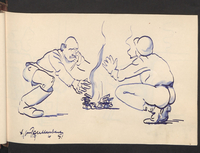
Rudolph Daniel Sichel papers
Document
The Rudolph Daniel Sichel papers include biographical materials, correspondence, military papers, photographs, printed materials, prisoner of war and witness reports, and a sketchbook containing drawings by German prisoners of war. The records documents Sichel’s immigration to the United States, training in Military Intelligence, service in the United States Army as an interrogator, and efforts to obtain restitution for the persecution of his family under Nazi Germany. Biographical materials include records related to the Sichels’ family history, clothing store in Frankfurt, immigration, and efforts to obtain restitution, Sichel’s passport and membership cards, and certificates for military service from Presidents Harry S. Truman and Jimmy Carter. Most of the correspondence files are comprised of letters from Sichel to his parents during the war. Of particular interest are Sichel’s selection of letters labeled “Highlights,” which describe his training, advance through Europe, meeting with Empress Hermine, visit to Nordhausen/Dora-Mittelbau, efforts to begin restitution proceedings for the family store, the deaths of relatives at Theresienstadt, the Deggendorf displaced persons camp, and the International Military Tribunal at Nuremberg. Correspondence files also include letter of introduction and recommendation for Sichel before the war and correspondence with family, friends, and Macy’s co-workers before, during, and after the war. Military papers include awards, commendation, and separation papers, Camp Ritchie training materials, and correspondence including orders, accounts of activities, reports to the Timberwolf Division, and lengthy communications between Sichel and the military after the war regarding his status and desire to be transferred to the Military Intelligence section of the Officers’ Reserve Corps. Military papers also include leaflets air-dropped by the Allies, ten marks in Allied Military Currency, maps, history and stationery related to the Timberwolves (104th Infantry Division), German organizational charts, Jewish prayer books for the American Armed Forces, and a newsletter distributed aboard the S.S. Sheepshead Bay Victory which brought Sichel back home. Photographic materials include three albums of snapshots taken by or of Sichel in Europe and hundreds of loose photographs documenting Sichel’s life in Germany, pre-war life in the United States, and wartime and postwar experiences. The albums trace Sichel’s progress, not necessarily in chronological order, through cities including Krostitz, Cologne, St. Brieu, Muir de Bretagne, Pontivy, Vannes, Atteln, Brakel, Halle, Teutchenthal, and Naumburg, and a post-war trip to the French Riviera. Of particular interest are Sichel’s snapshots taken at the Nordhausen/Dora-Mittelbau and Buchenwald concentration camps. Loose wartime photographs include landscapes, bombed out buildings and bridges, corpses, and airplane nose art. Additional photographs depict Sichel and his family and friends in Europe and the United States before, during, and after the war as well as the Sichels’ clothing store in Frankfurt, Macy’s employees, the S.S. Sheepshead Bay Victory, and the 1948 St. Moritz Olympics. The negatives in the collection correspond to some of the photographs of Nordhausen/Dora-Mittelbau, bombed out buildings, landscapes, military personnel, parades in England, and miscellaneous photographs as well as unidentified images of a family with young children. Printed materials include postcards from England, Belgium, France, and Germany, an English restaurant menu, stamps, handbills printed by the Christliche-Soziale Union, German-English and German-French dictionaries, and a newsletter published by the Textile Salesmen’s Association. The collection also includes clippings from American, British, and German newspapers including Yank, Die Neue Zeitung, Mittelbayerische Zeitung, and Täglische Rundschau, and Passauer Neue Presse, New York Sun, Daily News, and Deggendorf Center Revue mentioning Sichel or describing the war and its aftermath. Prisoner of war and witness reports document people and subjects including Dr. Friedrich Weber, Dachau Commandant Martin Weiss and other concentration camp personnel, cleanup after the Warsaw Ghetto Uprising, euthanasia at Hartheim, the war in Russia, and the Kovno Ghetto. The sketchbook in the collection was presented to Sichel by prisoners of war Kodak, Weigand, and Plettenberg describing themselves as “Der Unfreie Künstlerbund.” The book contains original pencil, ink, and watercolor drawings signed by the artists and depicting Sichel and prisoner of war camp life.
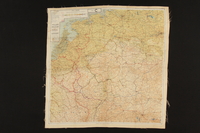
Two-sided silk escape map of Western Europe acquired by German Jewish US soldier
Object
Two-sided silk escape map of Western Europe carried by Rudolph Sichel, a Jewish refugee from Frankfurt, Germany, who was a US Army officer in Europe from July 1944-June 1946. In May 1936, unable to return to Germany from England because of anti-Jewish regulations, Sichel went to the US. His parents Ernst and Frieda joined him in 1940. In April 1943, Sichel enlisted in the Army and was sent to Camp Ritchie for military intelligence training. In July 1944, Sichel, Chief Interrogator, Interrogation of Prisoners of War Team 13, landed on Utah Beach in France, attached to the 104th Infantry, the Timberwolf Division. As the unit advanced through France, Belgium, and Germany, Sichel interrogated those captured. On April 11, 1945, the unit liberated Dora-Mittelbau/Nordhausen concentration camp. Sichel took photographs of the camp and other wartime events, which are part of this collection, 2003.149.1. After the war ended in May, 2nd Lt. Sichel was attached to the 9th Army. He interrogated prisoners of war and civilian witnesses and did fact finding missions for war crimes trials. In June 1946, 1st Lt. Sichel returned to the US. He was awarded a Bronze Star for his service.
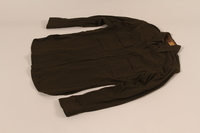
First lieutenant dress jacket, medals and shirt worn by German Jewish US soldier
Object
Olive drab dress uniform jacket with shirt and medals worn by Rudolph Sichel, a Jewish refugee from Frankfurt, Germany, who was a US Army officer in Europe from July 1944-June 1946. In May 1936, unable to return to Germany from England because of anti-Jewish regulations, Sichel went to the US. His parents Ernst and Frieda joined him in 1940. In April 1943, Sichel enlisted in the Army and was sent to Camp Ritchie for military intelligence training. In July 1944, Sichel, Chief Interrogator, Interrogation of Prisoners of War Team 13, landed on Utah Beach in France, attached to the 104th Infantry, the Timberwolf Division. As the unit advanced through France, Belgium, and Germany, Sichel interrogated those captured. On April 11, 1945, the unit liberated Dora-Mittelbau/Nordhausen concentration camp. Sichel took photographs of the camp and other wartime events, which are part of this collection, 2003.149.1. After the war ended in May, 2nd Lt. Sichel was attached to the 9th Army. He interrogated prisoners of war and civilian witnesses and did fact finding missions for war crimes trials. In June 1946, 1st Lt. Sichel returned to the US. He was awarded a Bronze Star for his service.
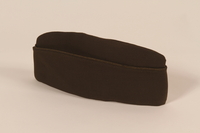
Officer's garrison cap worn by a German Jewish US soldier
Object
Olive drab garrison cap with black and gold piping worn by Rudolph Sichel, a Jewish refugee from Frankfurt, Germany, who was a US Army officer in Europe from July 1944-June 1946. In May 1936, unable to return to Germany from England because of anti-Jewish regulations, Sichel went to the US. His parents Ernst and Frieda joined him in 1940. In April 1943, Sichel enlisted in the Army and was sent to Camp Ritchie for military intelligence training. In July 1944, Sichel, Chief Interrogator, Interrogation of Prisoners of War Team 13, landed on Utah Beach in France, attached to the 104th Infantry, the Timberwolf Division. As the unit advanced through France, Belgium, and Germany, Sichel interrogated those captured. On April 11, 1945, the unit liberated Dora-Mittelbau/Nordhausen concentration camp. Sichel took photographs of the camp and other wartime events, which are part of this collection, 2003.149.1. After the war ended in May, 2nd Lt. Sichel was attached to the 9th Army. He interrogated prisoners of war and civilian witnesses and did fact finding missions for war crimes trials. In June 1946, 1st Lt. Sichel returned to the US. He was awarded a Bronze Star for his service.
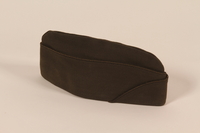
Officer's garrison cap worn by German Jewish US soldier
Object
Olive drab garrison cap with black and gold piping worn by Rudolph Sichel, a Jewish refugee from Frankfurt, Germany, who was a US Army officer in Europe from July 1944-June 1946. In May 1936, unable to return to Germany from England because of anti-Jewish regulations, Sichel went to the US. His parents Ernst and Frieda joined him in 1940. In April 1943, Sichel enlisted in the Army and was sent to Camp Ritchie for military intelligence training. In July 1944, Sichel, Chief Interrogator, Interrogation of Prisoners of War Team 13, landed on Utah Beach in France, attached to the 104th Infantry, the Timberwolf Division. As the unit advanced through France, Belgium, and Germany, Sichel interrogated those captured. On April 11, 1945, the unit liberated Dora-Mittelbau/Nordhausen concentration camp. Sichel took photographs of the camp and other wartime events, which are part of this collection, 2003.149.1. After the war ended in May, 2nd Lt. Sichel was attached to the 9th Army. He interrogated prisoners of war and civilian witnesses and did fact finding missions for war crimes trials. In June 1946, 1st Lt. Sichel returned to the US. He was awarded a Bronze Star for his service.
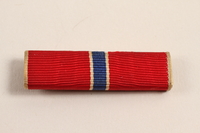
Bronze Star ribbon bar awarded to a Jewish German US soldier
Object
Bronze Star ribbon bar awarded to Rudolph Sichel, a Jewish refugee from Frankfurt, Germany, for heroic, meritorious achievement in the US Army in Europe from July 1944 to June 1946. In May 1946, Sichel was unable to return to Frankfurt, Germany, from England due to anti-Jewish restrictions so he went to the US. His parents Ernst and Frieda joined him in 1940. In April 1943, Sichel enlisted in the Army and was sent to Camp Ritchie for military intelligence training. In July 1944, Sichel, Chief Interrogator, Interrogation of Prisoners of War Team 13, landed on Utah Beach in France, attached to the 104th Infantry, the Timberwolf Division. As the unit advanced through France, Belgium, and Germany, Sichel interrogated those captured. On April 11, 1945, the unit liberated Dora-Mittelbau/Nordhausen concentration camp. Sichel took photographs of the camp and other wartime events, which are part of this collection, 2003.149.1. After the war ended in May, 2nd Lt. Sichel was attached to the 9th Army. He interrogated prisoners of war and civilian witnesses and did fact finding missions for war crimes trials. In June 1946, 1st Lt. Sichel returned to the US.
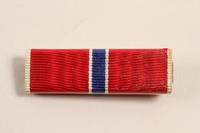
Bronze Star ribbon bar awarded to a Jewish German US soldier
Object
Bronze Star ribbon bar awarded to Rudolph Sichel, a Jewish refugee from Frankfurt, Germany, for heroic, meritorious achievement in the US Army in Europe from July 1944 to June 1946. In May 1946, Sichel was unable to return to Frankfurt, Germany, from England due to anti-Jewish restrictions so he went to the US. His parents Ernst and Frieda joined him in 1940. In April 1943, Sichel enlisted in the Army and was sent to Camp Ritchie for military intelligence training. In July 1944, Sichel, Chief Interrogator, Interrogation of Prisoners of War Team 13, landed on Utah Beach in France, attached to the 104th Infantry, the Timberwolf Division. As the unit advanced through France, Belgium, and Germany, Sichel interrogated those captured. On April 11, 1945, the unit liberated Dora-Mittelbau/Nordhausen concentration camp. Sichel took photographs of the camp and other wartime events, which are part of this collection, 2003.149.1. After the war ended in May, 2nd Lt. Sichel was attached to the 9th Army. He interrogated prisoners of war and civilian witnesses and did fact finding missions for war crimes trials. In June 1946, 1st Lt. Sichel returned to the US.
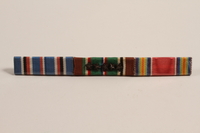
Ribbon bar with 3 campaign ribbons issued to a Jewish German US soldier
Object
Triple ribbon bar for these medals: American Campaign, European-African-Middle Eastern Campaign, and World War II Victory, received by Rudolph Sichel, a Jewish refugee from Frankfurt, Germany, for his service in the US Army in Europe from July 1944 to June 1946. In May 1936, unable to return to Germany from England because of anti-Jewish regulations, Sichel went to the US. His parents Ernst and Frieda joined him in 1940. In April 1943, Sichel enlisted in the Army and was sent to Camp Ritchie for military intelligence training. In July 1944, Sichel, Chief Interrogator, Interrogation of Prisoners of War Team 13, landed on Utah Beach in France, attached to the 104th Infantry, the Timberwolf Division. As the unit advanced through France, Belgium, and Germany, Sichel interrogated those captured. On April 11, 1945, the unit liberated Dora-Mittelbau/Nordhausen concentration camp. Sichel took photographs of the camp and other wartime events, which are part of this collection, 2003.149.1. After the war ended in May, 2nd Lt. Sichel was attached to the 9th Army. He interrogated prisoners of war and civilian witnesses and did fact finding missions for war crimes trials. In June 1946, 1st Lt. Sichel returned to the US. He was awarded a Bronze Star for his service.
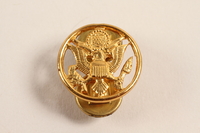
Great Seal of US lapel pin worn by a Jewish German US soldier
Object
Lapel pin with the United States Seal worn by Rudolph Sichel, a Jewish refugee from Frankfurt, Germany, who served in the US Army from 1943 to June 1946. In May 1936, unable to return to Germany from England because of anti-Jewish regulations, Sichel went to the US. His parents Ernst and Frieda joined him in 1940. In April 1943, Sichel enlisted in the Army and was sent to Camp Ritchie for military intelligence training. In July 1944, Sichel, Chief Interrogator, Interrogation of Prisoners of War Team 13, landed on Utah Beach in France, attached to the 104th Infantry, the Timberwolf Division. As the unit advanced through France, Belgium, and Germany, Sichel interrogated those captured. On April 11, 1945, the unit liberated Dora-Mittelbau/Nordhausen concentration camp. Sichel took photographs of the camp and other wartime events, which are part of this collection, 2003.149.1. After the war ended in May, 2nd Lt. Sichel was attached to the 9th Army. He interrogated prisoners of war and civilian witnesses and did fact finding missions for war crimes trials. In June 1946, 1st Lt. Sichel returned to the US. He was awarded a Bronze Star for his service.
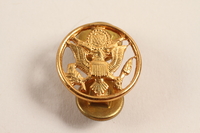
Great Seal of US lapel pin worn by a Jewish German US soldier
Object
Lapel pin with the United States Seal used by Rudolph Sichel, a Jewish refugee from Frankfurt, Germany, who served in the US Army from 1943 to June 1946. In May 1936, unable to return to Germany from England because of anti-Jewish regulations, Sichel went to the US. His parents Ernst and Frieda joined him in 1940. In April 1943, Sichel enlisted in the Army and was sent to Camp Ritchie for military intelligence training. In July 1944, Sichel, Chief Interrogator, Interrogation of Prisoners of War Team 13, landed on Utah Beach in France, attached to the 104th Infantry, the Timberwolf Division. As the unit advanced through France, Belgium, and Germany, Sichel interrogated those captured. On April 11, 1945, the unit liberated Dora-Mittelbau/Nordhausen concentration camp. Sichel took photographs of the camp and other wartime events, which are part of this collection, 2003.149.1. After the war ended in May, 2nd Lt. Sichel was attached to the 9th Army. He interrogated prisoners of war and civilian witnesses and did fact finding missions for war crimes trials. In June 1946, 1st Lt. Sichel returned to the US. He was awarded a Bronze Star for his service.
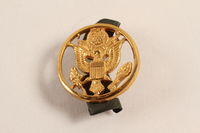
Great Seal of US lapel pin worn by a Jewish German US soldier
Object
Lapel pin with the United States Seal used by Rudolph Sichel, a Jewish refugee from Frankfurt, Germany, who served in the US Army from 1943 to June 1946. In May 1936, unable to return to Germany from England because of anti-Jewish regulations, Sichel went to the US. His parents Ernst and Frieda joined him in 1940. In April 1943, Sichel enlisted in the Army and was sent to Camp Ritchie for military intelligence training. In July 1944, Sichel, Chief Interrogator, Interrogation of Prisoners of War Team 13, landed on Utah Beach in France, attached to the 104th Infantry, the Timberwolf Division. As the unit advanced through France, Belgium, and Germany, Sichel interrogated those captured. On April 11, 1945, the unit liberated Dora-Mittelbau/Nordhausen concentration camp. Sichel took photographs of the camp and other wartime events, which are part of this collection, 2003.149.1. After the war ended in May, 2nd Lt. Sichel was attached to the 9th Army. He interrogated prisoners of war and civilian witnesses and did fact finding missions for war crimes trials. In June 1946, 1st Lt. Sichel returned to the US. He was awarded a Bronze Star for his service.
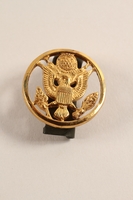
Great Seal of US lapel pin worn by a Jewish German US soldier
Object
Lapel pin with the United States Seal used by Rudolph Sichel, a Jewish refugee from Frankfurt, Germany, who served in the US Army from 1943 to June 1946. In May 1936, unable to return to Germany from England because of anti-Jewish regulations, Sichel went to the US. His parents Ernst and Frieda joined him in 1940. In April 1943, Sichel enlisted in the Army and was sent to Camp Ritchie for military intelligence training. In July 1944, Sichel, Chief Interrogator, Interrogation of Prisoners of War Team 13, landed on Utah Beach in France, attached to the 104th Infantry, the Timberwolf Division. As the unit advanced through France, Belgium, and Germany, Sichel interrogated those captured. On April 11, 1945, the unit liberated Dora-Mittelbau/Nordhausen concentration camp. Sichel took photographs of the camp and other wartime events, which are part of this collection, 2003.149.1. After the war ended in May, 2nd Lt. Sichel was attached to the 9th Army. He interrogated prisoners of war and civilian witnesses and did fact finding missions for war crimes trials. In June 1946, 1st Lt. Sichel returned to the US. He was awarded a Bronze Star for his service.
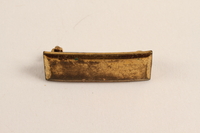
2nd Lieutenant's insignia pin worn by a Jewish German US soldier
Object
Second Lieutenant's insignia pin worn by Rudolph Sichel, a Jewish refugee from Frankfurt, Germany, who served in the US Army from 1943 to June 1946, from 1945-1946 as a 2nd Lieutenant. In May 1936, unable to return to Germany from England because of anti-Jewish regulations, Sichel went to the US. His parents Ernst and Frieda joined him in 1940. In April 1943, Sichel enlisted in the Army and was sent to Camp Ritchie for military intelligence training. In July 1944, Sichel, Chief Interrogator, Interrogation of Prisoners of War Team 13, landed on Utah Beach in France, attached to the 104th Infantry, the Timberwolf Division. As the unit advanced through France, Belgium, and Germany, Sichel interrogated those captured. On April 11, 1945, the unit liberated Dora-Mittelbau/Nordhausen concentration camp. Sichel took photographs of the camp and other wartime events, which are part of this collection, 2003.149.1. After the war ended in May, 2nd Lt. Sichel was attached to the 9th Army. He interrogated prisoners of war and civilian witnesses and did fact finding missions for war crimes trials. In June 1946, 1st Lt. Sichel returned to the US. He was awarded a Bronze Star for his service.
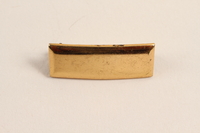
2nd Lieutenant's insignia pin worn by a Jewish German US soldier
Object
Second Lieutenant's insignia pin worn by Rudolph Sichel, a Jewish refugee from Frankfurt, Germany, who served in the US Army from 1943 to June 1946, from 1945-1946 as a 2nd Lieutenant. In May 1936, unable to return to Germany from England because of anti-Jewish regulations, Sichel went to the US. His parents Ernst and Frieda joined him in 1940. In April 1943, Sichel enlisted in the Army and was sent to Camp Ritchie for military intelligence training. In July 1944, Sichel, Chief Interrogator, Interrogation of Prisoners of War Team 13, landed on Utah Beach in France, attached to the 104th Infantry, the Timberwolf Division. As the unit advanced through France, Belgium, and Germany, Sichel interrogated those captured. On April 11, 1945, the unit liberated Dora-Mittelbau/Nordhausen concentration camp. Sichel took photographs of the camp and other wartime events, which are part of this collection, 2003.149.1. After the war ended in May, 2nd Lt. Sichel was attached to the 9th Army. He interrogated prisoners of war and civilian witnesses and did fact finding missions for war crimes trials. In June 1946, 1st Lt. Sichel returned to the US. He was awarded a Bronze Star for his service.
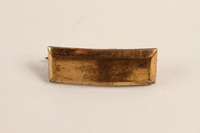
Second Lieutenant's insignia pin worn by a Jewish German US soldier
Object
Second Lieutenant's insignia pin worn by Rudolph Sichel, a Jewish refugee from Frankfurt, Germany, who served in the US Army from 1943 to June 1946, from 1945-1946 as a 2nd Lieutenant. In May 1936, unable to return to Germany from England because of anti-Jewish regulations, Sichel went to the US. His parents Ernst and Frieda joined him in 1940. In April 1943, Sichel enlisted in the Army and was sent to Camp Ritchie for military intelligence training. In July 1944, Sichel, Chief Interrogator, Interrogation of Prisoners of War Team 13, landed on Utah Beach in France, attached to the 104th Infantry, the Timberwolf Division. As the unit advanced through France, Belgium, and Germany, Sichel interrogated those captured. On April 11, 1945, the unit liberated Dora-Mittelbau/Nordhausen concentration camp. Sichel took photographs of the camp and other wartime events, which are part of this collection, 2003.149.1. After the war ended in May, 2nd Lt. Sichel was attached to the 9th Army. He interrogated prisoners of war and civilian witnesses and did fact finding missions for war crimes trials. In June 1946, 1st Lt. Sichel returned to the US. He was awarded a Bronze Star for his service.

Second Lieutenant's bullion patch worn by a Jewish German US soldier
Object
Second Lieutenant's bullion patch worn by Rudolph Sichel, a Jewish refugee from Frankfurt, Germany, who served in the US Army from 1943 to June 1946, from 1945-1946 as a 2nd Lieutenant. In May 1936, unable to return to Germany from England because of anti-Jewish regulations, Sichel went to the US. His parents Ernst and Frieda joined him in 1940. In April 1943, Sichel enlisted in the Army and was sent to Camp Ritchie for military intelligence training. In July 1944, Sichel, Chief Interrogator, Interrogation of Prisoners of War Team 13, landed on Utah Beach in France, attached to the 104th Infantry, the Timberwolf Division. As the unit advanced through France, Belgium, and Germany, Sichel interrogated those captured. On April 11, 1945, the unit liberated Dora-Mittelbau/Nordhausen concentration camp. Sichel took photographs of the camp and other wartime events, which are part of this collection, 2003.149.1. After the war ended in May, 2nd Lt. Sichel was attached to the 9th Army. He interrogated prisoners of war and civilian witnesses and did fact finding missions for war crimes trials. In June 1946, 1st Lt. Sichel returned to the US. He was awarded a Bronze Star for his service.
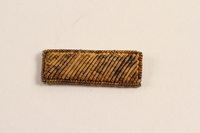
Second Lieutenant's bullion patch worn by a Jewish German US soldier
Object
Second Lieutenant's bullion patch worn by Rudolph Sichel, a Jewish refugee from Frankfurt, Germany, who served in the US Army from 1943 to June 1946, from 1945-1946 as a 2nd Lieutenant. In May 1936, unable to return to Germany from England because of anti-Jewish regulations, Sichel went to the US. His parents Ernst and Frieda joined him in 1940. In April 1943, Sichel enlisted in the Army and was sent to Camp Ritchie for military intelligence training. In July 1944, Sichel, Chief Interrogator, Interrogation of Prisoners of War Team 13, landed on Utah Beach in France, attached to the 104th Infantry, the Timberwolf Division. As the unit advanced through France, Belgium, and Germany, Sichel interrogated those captured. On April 11, 1945, the unit liberated Dora-Mittelbau/Nordhausen concentration camp. Sichel took photographs of the camp and other wartime events, which are part of this collection, 2003.149.1. After the war ended in May, 2nd Lt. Sichel was attached to the 9th Army. He interrogated prisoners of war and civilian witnesses and did fact finding missions for war crimes trials. In June 1946, 1st Lt. Sichel returned to the US. He was awarded a Bronze Star for his service.
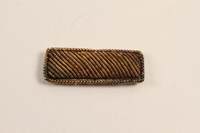
Second Lieutenant's bullion patch worn by a Jewish German US soldier
Object
Second Lieutenant's bullion patch worn by Rudolph Sichel, a Jewish refugee from Frankfurt, Germany, who served in the US Army from 1943 to June 1946, from 1945-1946 as a 2nd Lieutenant. In May 1936, unable to return to Germany from England because of anti-Jewish regulations, Sichel went to the US. His parents Ernst and Frieda joined him in 1940. In April 1943, Sichel enlisted in the Army and was sent to Camp Ritchie for military intelligence training. In July 1944, Sichel, Chief Interrogator, Interrogation of Prisoners of War Team 13, landed on Utah Beach in France, attached to the 104th Infantry, the Timberwolf Division. As the unit advanced through France, Belgium, and Germany, Sichel interrogated those captured. On April 11, 1945, the unit liberated Dora-Mittelbau/Nordhausen concentration camp. Sichel took photographs of the camp and other wartime events, which are part of this collection, 2003.149.1. After the war ended in May, 2nd Lt. Sichel was attached to the 9th Army. He interrogated prisoners of war and civilian witnesses and did fact finding missions for war crimes trials. In June 1946, 1st Lt. Sichel returned to the US. He was awarded a Bronze Star for his service.
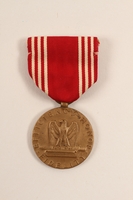
Good Conduct medal and ribbon issued to a German Jewish German US soldier
Object
Good Conduct medal and ribbon presented to Rudolph Sichel, a Jewish refugee from Frankfurt, Germany, who served in the US Army from 1943 to June 1946. In May 1936, unable to return to Germany from England because of anti-Jewish regulations, Sichel went to the US. His parents Ernst and Frieda joined him in 1940. In April 1943, Sichel enlisted in the Army and was sent to Camp Ritchie for military intelligence training. In July 1944, Sichel, Chief Interrogator, Interrogation of Prisoners of War Team 13, landed on Utah Beach in France, attached to the 104th Infantry, the Timberwolf Division. As the unit advanced through France, Belgium, and Germany, Sichel interrogated those captured. On April 11, 1945, the unit liberated Dora-Mittelbau/Nordhausen concentration camp. Sichel took photographs of the camp and other wartime events, which are part of this collection, 2003.149.1. After the war ended in May, 2nd Lt. Sichel was attached to the 9th Army. He interrogated prisoners of war and civilian witnesses and did fact finding missions for war crimes trials. In June 1946, 1st Lt. Sichel returned to the US. He was awarded a Bronze Star for his service.
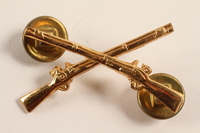
Infantry service lapel pin worn by a German Jewish US soldier
Object
Infantry service lapel pin worn by Rudolph Sichel, a Jewish refugee from Frankfurt, Germany, who served in the US Army from 1943 to June 1946. In May 1936, unable to return to Germany from England because of anti-Jewish regulations, Sichel went to the US. His parents Ernst and Frieda joined him in 1940. In April 1943, Sichel enlisted in the Army and was sent to Camp Ritchie for military intelligence training. In July 1944, Sichel, Chief Interrogator, Interrogation of Prisoners of War Team 13, landed on Utah Beach in France, attached to the 104th Infantry, the Timberwolf Division. As the unit advanced through France, Belgium, and Germany, Sichel interrogated those captured. On April 11, 1945, the unit liberated Dora-Mittelbau/Nordhausen concentration camp. Sichel took photographs of the camp and other wartime events, which are part of this collection, 2003.149.1. After the war ended in May, 2nd Lt. Sichel was attached to the 9th Army. He interrogated prisoners of war and civilian witnesses and did fact finding missions for war crimes trials. In June 1946, 1st Lt. Sichel returned to the US. He was awarded a Bronze Star for his service.
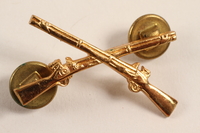
Infantry service lapel pin worn by a German Jewish US soldier
Object
Infantry service lapel pin worn by Rudolph Sichel, a Jewish refugee from Frankfurt, Germany, who served in the US Army from 1943 to June 1946. In May 1936, unable to return to Germany from England because of anti-Jewish regulations, Sichel went to the US. His parents Ernst and Frieda joined him in 1940. In April 1943, Sichel enlisted in the Army and was sent to Camp Ritchie for military intelligence training. In July 1944, Sichel, Chief Interrogator, Interrogation of Prisoners of War Team 13, landed on Utah Beach in France, attached to the 104th Infantry, the Timberwolf Division. As the unit advanced through France, Belgium, and Germany, Sichel interrogated those captured. On April 11, 1945, the unit liberated Dora-Mittelbau/Nordhausen concentration camp. Sichel took photographs of the camp and other wartime events, which are part of this collection, 2003.149.1. After the war ended in May, 2nd Lt. Sichel was attached to the 9th Army. He interrogated prisoners of war and civilian witnesses and did fact finding missions for war crimes trials. In June 1946, 1st Lt. Sichel returned to the US. He was awarded a Bronze Star for his service.

Infantry service lapel pin worn by German Jewish US soldier
Object
Infantry service lapel pin worn by Rudolph Sichel, a Jewish refugee from Frankfurt, Germany, who served in the US Army from 1943 to June 1946. In May 1936, unable to return to Germany from England because of anti-Jewish regulations, Sichel went to the US. His parents Ernst and Frieda joined him in 1940. In April 1943, Sichel enlisted in the Army and was sent to Camp Ritchie for military intelligence training. In July 1944, Sichel, Chief Interrogator, Interrogation of Prisoners of War Team 13, landed on Utah Beach in France, attached to the 104th Infantry, the Timberwolf Division. As the unit advanced through France, Belgium, and Germany, Sichel interrogated those captured. On April 11, 1945, the unit liberated Dora-Mittelbau/Nordhausen concentration camp. Sichel took photographs of the camp and other wartime events, which are part of this collection, 2003.149.1. After the war ended in May, 2nd Lt. Sichel was attached to the 9th Army. He interrogated prisoners of war and civilian witnesses and did fact finding missions for war crimes trials. In June 1946, 1st Lt. Sichel returned to the US. He was awarded a Bronze Star for his service.
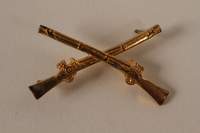
Infantry service lapel pin worn by a German Jewish US soldier
Object
Infantry service lapel pin worn by Rudolph Sichel, a Jewish refugee from Frankfurt, Germany, who served in the US Army from 1943 to June 1946. In May 1936, unable to return to Germany from England because of anti-Jewish regulations, Sichel went to the US. His parents Ernst and Frieda joined him in 1940. In April 1943, Sichel enlisted in the Army and was sent to Camp Ritchie for military intelligence training. In July 1944, Sichel, Chief Interrogator, Interrogation of Prisoners of War Team 13, landed on Utah Beach in France, attached to the 104th Infantry, the Timberwolf Division. As the unit advanced through France, Belgium, and Germany, Sichel interrogated those captured. On April 11, 1945, the unit liberated Dora-Mittelbau/Nordhausen concentration camp. Sichel took photographs of the camp and other wartime events, which are part of this collection, 2003.149.1. After the war ended in May, 2nd Lt. Sichel was attached to the 9th Army. He interrogated prisoners of war and civilian witnesses and did fact finding missions for war crimes trials. In June 1946, 1st Lt. Sichel returned to the US. He was awarded a Bronze Star for his service.
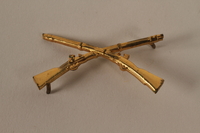
Infantry service lapel pin worn by a German Jewish US soldier
Object
Infantry service lapel pin worn by Rudolph Sichel, a Jewish refugee from Frankfurt, Germany, who served in the US Army from 1943 to June 1946. In May 1936, unable to return to Germany from England because of anti-Jewish regulations, Sichel went to the US. His parents Ernst and Frieda joined him in 1940. In April 1943, Sichel enlisted in the Army and was sent to Camp Ritchie for military intelligence training. In July 1944, Sichel, Chief Interrogator, Interrogation of Prisoners of War Team 13, landed on Utah Beach in France, attached to the 104th Infantry, the Timberwolf Division. As the unit advanced through France, Belgium, and Germany, Sichel interrogated those captured. On April 11, 1945, the unit liberated Dora-Mittelbau/Nordhausen concentration camp. Sichel took photographs of the camp and other wartime events, which are part of this collection, 2003.149.1. After the war ended in May, 2nd Lt. Sichel was attached to the 9th Army. He interrogated prisoners of war and civilian witnesses and did fact finding missions for war crimes trials. In June 1946, 1st Lt. Sichel returned to the US. He was awarded a Bronze Star for his service.
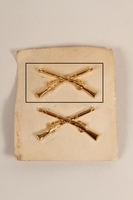
Infantry service lapel pin worn by a German Jewish US soldier
Object
Infantry service lapel pin worn by Rudolph Sichel, a Jewish refugee from Frankfurt, Germany, who served in the US Army from 1943 to June 1946. In May 1936, unable to return to Germany from England because of anti-Jewish regulations, Sichel went to the US. His parents Ernst and Frieda joined him in 1940. In April 1943, Sichel enlisted in the Army and was sent to Camp Ritchie for military intelligence training. In July 1944, Sichel, Chief Interrogator, Interrogation of Prisoners of War Team 13, landed on Utah Beach in France, attached to the 104th Infantry, the Timberwolf Division. As the unit advanced through France, Belgium, and Germany, Sichel interrogated those captured. On April 11, 1945, the unit liberated Dora-Mittelbau/Nordhausen concentration camp. Sichel took photographs of the camp and other wartime events, which are part of this collection, 2003.149.1. After the war ended in May, 2nd Lt. Sichel was attached to the 9th Army. He interrogated prisoners of war and civilian witnesses and did fact finding missions for war crimes trials. In June 1946, 1st Lt. Sichel returned to the US. He was awarded a Bronze Star for his service.
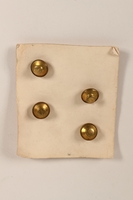
Infantry service lapel pin from a pair received by German Jewish US soldier
Object
Infantry service lapel pin received, as part of a set with pin .26.1, worn by Rudolph Sichel, a Jewish refugee from Frankfurt, Germany, who was a US Army officer in Europe from July 1944-June 1946. In May 1936, unable to return to Germany from England because of anti-Jewish regulations, Sichel went to the US. His parents Ernst and Frieda joined him in 1940. In April 1943, Sichel enlisted in the Army and was sent to Camp Ritchie for military intelligence training. In July 1944, Sichel, Chief Interrogator, Interrogation of Prisoners of War Team 13, landed on Utah Beach in France, attached to the 104th Infantry, the Timberwolf Division. As the unit advanced through France, Belgium, and Germany, Sichel interrogated those captured. On April 11, 1945, the unit liberated Dora-Mittelbau/Nordhausen concentration camp. Sichel took photographs of the camp and other wartime events, which are part of this collection, 2003.149.1. After the war ended in May, 2nd Lt. Sichel was attached to the 9th Army. He interrogated prisoners of war and civilian witnesses and did fact finding missions for war crimes trials. In June 1946, 1st Lt. Sichel returned to the US. He was awarded a Bronze Star for his service.
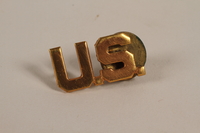
U.S. lapel pin worn by a German Jewish US soldier
Object
U.S. lapel pin worn by Rudolph Sichel, a Jewish refugee from Frankfurt, Germany, who served in the US Army from 1943 to June 1946. In May 1936, unable to return to Germany from England because of anti-Jewish regulations, Sichel went to the US. His parents Ernst and Frieda joined him in 1940. In April 1943, Sichel enlisted in the Army and was sent to Camp Ritchie for military intelligence training. In July 1944, Sichel, Chief Interrogator, Interrogation of Prisoners of War Team 13, landed on Utah Beach in France, attached to the 104th Infantry, the Timberwolf Division. As the unit advanced through France, Belgium, and Germany, Sichel interrogated those captured. On April 11, 1945, the unit liberated Dora-Mittelbau/Nordhausen concentration camp. Sichel took photographs of the camp and other wartime events, which are part of this collection, 2003.149.1. After the war ended in May, 2nd Lt. Sichel was attached to the 9th Army. He interrogated prisoners of war and civilian witnesses and did fact finding missions for war crimes trials. In June 1946, 1st Lt. Sichel returned to the US. He was awarded a Bronze Star for his service.
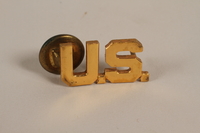
U.S. lapel pin worn by a German Jewish German US soldier
Object
U.S. lapel pin used by 30 year old Rudolph Sichel, a Jewish refugee from Frankfurt, Germany, during his service as an officer in the US Army in Europe from 1945 to 1946. In May 1936, unable to return to Germany from England because of anti-Jewish regulations, Sichel went to the US. His parents Ernst and Frieda joined him in 1940. In April 1943, Sichel enlisted in the Army and was sent to Camp Ritchie for military intelligence training. In July 1944, Sichel, Chief Interrogator, Interrogation of Prisoners of War Team 13, landed on Utah Beach in France, attached to the 104th Infantry, the Timberwolf Division. As the unit advanced through France, Belgium, and Germany, Sichel interrogated those captured. On April 11, 1945, the unit liberated Dora-Mittelbau/Nordhausen concentration camp. Sichel took photographs of the camp and other wartime events, which are part of this collection, 2003.149.1. After the war ended in May, 2nd Lt. Sichel was attached to the 9th Army. He interrogated prisoners of war and civilian witnesses and did fact finding missions for war crimes trials. In June 1946, 1st Lt. Sichel returned to the US. He was awarded a Bronze Star for his service.
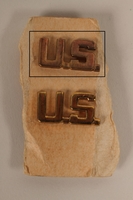
Copper colored U.S. lapel pin received by a German Jewish US soldier
Object
U.S. lapel pin received as part of a set with pin .29.2, by 30 year old Rudolph Sichel, a Jewish refugee from Frankfurt, Germany, during his service as an officer in the US Army in Europe from 1945 to 1946. In May 1936, unable to return to Germany from England because of anti-Jewish regulations, Sichel went to the US. His parents Ernst and Frieda joined him in 1940. In April 1943, Sichel enlisted in the Army and was sent to Camp Ritchie for military intelligence training. In July 1944, Sichel, Chief Interrogator, Interrogation of Prisoners of War Team 13, landed on Utah Beach in France, attached to the 104th Infantry, the Timberwolf Division. As the unit advanced through France, Belgium, and Germany, Sichel interrogated those captured. On April 11, 1945, the unit liberated Dora-Mittelbau/Nordhausen concentration camp. Sichel took photographs of the camp and other wartime events, which are part of this collection, 2003.149.1. After the war ended in May, 2nd Lt. Sichel was attached to the 9th Army. He interrogated prisoners of war and civilian witnesses and did fact finding missions for war crimes trials. In June 1946, 1st Lt. Sichel returned to the US. He was awarded a Bronze Star for his service.
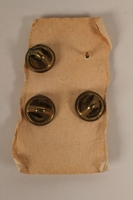
U.S. lapel pin from a pair owned by a German Jewish US soldier
Object
U.S. lapel pin received as part of a set with pin .29.1, by 30 year old Rudolph Sichel, a Jewish refugee from Frankfurt, Germany, during his service as an officer in the US Army in Europe from 1945 to 1946. In May 1936, unable to return to Germany from England because of anti-Jewish regulations, Sichel went to the US. His parents Ernst and Frieda joined him in 1940. In April 1943, Sichel enlisted in the Army and was sent to Camp Ritchie for military intelligence training. In July 1944, Sichel, Chief Interrogator, Interrogation of Prisoners of War Team 13, landed on Utah Beach in France, attached to the 104th Infantry, the Timberwolf Division. As the unit advanced through France, Belgium, and Germany, Sichel interrogated those captured. On April 11, 1945, the unit liberated Dora-Mittelbau/Nordhausen concentration camp. Sichel took photographs of the camp and other wartime events, which are part of this collection, 2003.149.1. After the war ended in May, 2nd Lt. Sichel was attached to the 9th Army. He interrogated prisoners of war and civilian witnesses and did fact finding missions for war crimes trials. In June 1946, 1st Lt. Sichel returned to the US. He was awarded a Bronze Star for his service.
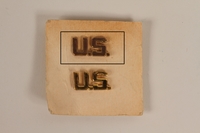
Copper colored U.S. lapel pin owned by a German Jewish US soldier
Object
U.S. lapel pin received as part of a set with pin .30.2, by Rudolph Sichel, a Jewish refugee from Frankfurt, Germany, during his service as an officer in the US Army in Europe from 1945 to 1946. In May 1936, unable to return to Germany from England because of anti-Jewish regulations, Sichel went to the US. His parents Ernst and Frieda joined him in 1940. In April 1943, Sichel enlisted in the Army and was sent to Camp Ritchie for military intelligence training. In July 1944, Sichel, Chief Interrogator, Interrogation of Prisoners of War Team 13, landed on Utah Beach in France, attached to the 104th Infantry, the Timberwolf Division. As the unit advanced through France, Belgium, and Germany, Sichel interrogated those captured. On April 11, 1945, the unit liberated Dora-Mittelbau/Nordhausen concentration camp. Sichel took photographs of the camp and other wartime events, which are part of this collection, 2003.149.1. After the war ended in May, 2nd Lt. Sichel was attached to the 9th Army. He interrogated prisoners of war and civilian witnesses and did fact finding missions for war crimes trials. In June 1946, 1st Lt. Sichel returned to the US. He was awarded a Bronze Star for his service.
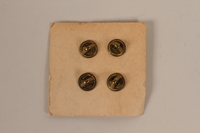
U.S. lapel pin received by a German Jewish US soldier
Object
U.S. lapel pin received as part of a set with pin .30.1, by Rudolph Sichel, a Jewish refugee from Frankfurt, Germany, who was a US Army officer in Europe from July 1944-June 1946. In May 1936, unable to return to Germany from England because of anti-Jewish regulations, Sichel went to the US. His parents Ernst and Frieda joined him in 1940. In April 1943, Sichel enlisted in the Army and was sent to Camp Ritchie for military intelligence training. In July 1944, Sichel, Chief Interrogator, Interrogation of Prisoners of War Team 13, landed on Utah Beach in France, attached to the 104th Infantry, the Timberwolf Division. As the unit advanced through France, Belgium, and Germany, Sichel interrogated those captured. On April 11, 1945, the unit liberated Dora-Mittelbau/Nordhausen concentration camp. Sichel took photographs of the camp and other wartime events, which are part of this collection, 2003.149.1. After the war ended in May, 2nd Lt. Sichel was attached to the 9th Army. He interrogated prisoners of war and civilian witnesses and did fact finding missions for war crimes trials. In June 1946, 1st Lt. Sichel returned to the US. He was awarded a Bronze Star for his service.
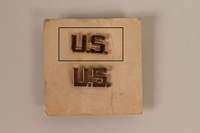
U.S. lapel pin received by a German Jewish US soldier
Object
U.S. lapel pin received as part of a set with pin .31.2, by Rudolph Sichel, a Jewish refugee from Frankfurt, Germany, during his service as an officer in the US Army in Europe from 1945 to 1946. In May 1936, unable to return to Germany from England because of anti-Jewish regulations, Sichel went to the US. His parents Ernst and Frieda joined him in 1940. In April 1943, Sichel enlisted in the Army and was sent to Camp Ritchie for military intelligence training. In July 1944, Sichel, Chief Interrogator, Interrogation of Prisoners of War Team 13, landed on Utah Beach in France, attached to the 104th Infantry, the Timberwolf Division. As the unit advanced through France, Belgium, and Germany, Sichel interrogated those captured. On April 11, 1945, the unit liberated Dora-Mittelbau/Nordhausen concentration camp. Sichel took photographs of the camp and other wartime events, which are part of this collection, 2003.149.1. After the war ended in May, 2nd Lt. Sichel was attached to the 9th Army. He interrogated prisoners of war and civilian witnesses and did fact finding missions for war crimes trials. In June 1946, 1st Lt. Sichel returned to the US. He was awarded a Bronze Star for his service.
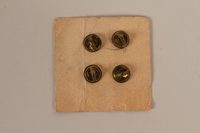
Copper colored U.S. lapel pin received by a German Jewish US soldier
Object
U.S. lapel pin received as part of a set with pin .31.1, by Rudolph Sichel, a Jewish refugee from Frankfurt, Germany, during his service as an officer in the US Army in Europe from 1945 to 1946. In May 1936, unable to return to Germany from England because of anti-Jewish regulations, Sichel went to the US. His parents Ernst and Frieda joined him in 1940. In April 1943, Sichel enlisted in the Army and was sent to Camp Ritchie for military intelligence training. In July 1944, Sichel, Chief Interrogator, Interrogation of Prisoners of War Team 13, landed on Utah Beach in France, attached to the 104th Infantry, the Timberwolf Division. As the unit advanced through France, Belgium, and Germany, Sichel interrogated those captured. On April 11, 1945, the unit liberated Dora-Mittelbau/Nordhausen concentration camp. Sichel took photographs of the camp and other wartime events, which are part of this collection, 2003.149.1. After the war ended in May, 2nd Lt. Sichel was attached to the 9th Army. He interrogated prisoners of war and civilian witnesses and did fact finding missions for war crimes trials. In June 1946, 1st Lt. Sichel returned to the US. He was awarded a Bronze Star for his service.
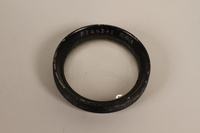
Plaubel R O,1 clear camera lens and case used by German Jewish German US soldier
Object
Plaubel R 0,1 clear lens and fitted leather case, likely for use with a Makina II camera, owned by Rudolph Sichel, a Jewish refugee from Frankfurt, Germany, who was a US Army officer in Europe from July 1944-June 1946. In May 1936, unable to return to Germany from England because of anti-Jewish regulations, Sichel went to the US. His parents Ernst and Frieda joined him in 1940. In April 1943, Sichel enlisted in the Army and was sent to Camp Ritchie for military intelligence training. In July 1944, Sichel, Chief Interrogator, Interrogation of Prisoners of War Team 13, landed on Utah Beach in France, attached to the 104th Infantry, the Timberwolf Division. As the unit advanced through France, Belgium, and Germany, Sichel interrogated those captured. On April 11, 1945, the unit liberated Dora-Mittelbau/Nordhausen concentration camp. Sichel took photographs of the camp and other wartime events, which are part of this collection, 2003.149.1. After the war ended in May, 2nd Lt. Sichel was attached to the 9th Army. He interrogated prisoners of war and civilian witnesses and did fact finding missions for war crimes trials. In June 1946, 1st Lt. Sichel returned to the US. He was awarded a Bronze Star for his service.
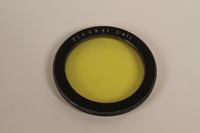
Plaubel yellow camera filter and case used by German Jewish US soldier
Object
Plaubel yellow filter and fitted leather case, likely for use with a Makina II camera, owned by Rudolph Sichel, a Jewish refugee from Frankfurt, Germany, who was a US Army officer in Europe from July 1944-June 1946. In May 1936, unable to return to Germany from England because of anti-Jewish regulations, Sichel went to the US. His parents Ernst and Frieda joined him in 1940. In April 1943, Sichel enlisted in the Army and was sent to Camp Ritchie for military intelligence training. In July 1944, Sichel, Chief Interrogator, Interrogation of Prisoners of War Team 13, landed on Utah Beach in France, attached to the 104th Infantry, the Timberwolf Division. As the unit advanced through France, Belgium, and Germany, Sichel interrogated those captured. On April 11, 1945, the unit liberated Dora-Mittelbau/Nordhausen concentration camp. Sichel took photographs of the camp and other wartime events, which are part of this collection, 2003.149.1. After the war ended in May, 2nd Lt. Sichel was attached to the 9th Army. He interrogated prisoners of war and civilian witnesses and did fact finding missions for war crimes trials. In June 1946, 1st Lt. Sichel returned to the US. He was awarded a Bronze Star for his service.
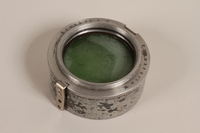
Plaubel camera lens hood with green filter and case used by German Jewish US soldier
Object
Plaubel camera hood with green filter and fitted leather case, likely for use with a Makina II camera, owned by Rudolph Sichel, a Jewish refugee from Frankfurt, Germany, who was a US Army officer in Europe from July 1944-June 1946. In May 1936, unable to return to Germany from England because of anti-Jewish regulations, Sichel went to the US. His parents Ernst and Frieda joined him in 1940. In April 1943, Sichel enlisted in the Army and was sent to Camp Ritchie for military intelligence training. In July 1944, Sichel, Chief Interrogator, Interrogation of Prisoners of War Team 13, landed on Utah Beach in France, attached to the 104th Infantry, the Timberwolf Division. As the unit advanced through France, Belgium, and Germany, Sichel interrogated those captured. On April 11, 1945, the unit liberated Dora-Mittelbau/Nordhausen concentration camp. Sichel took photographs of the camp and other wartime events, which are part of this collection, 2003.149.1. After the war ended in May, 2nd Lt. Sichel was attached to the 9th Army. He interrogated prisoners of war and civilian witnesses and did fact finding missions for war crimes trials. In June 1946, 1st Lt. Sichel returned to the US. He was awarded a Bronze Star for his service.
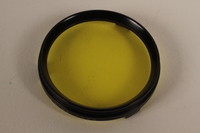
Zeiss Ikon camera filter, case, and box used by German Jewish US soldier
Object
Zeiss Ikon yellow camera filter with leather case and box owned by Rudolph Sichel, a Jewish refugee from Frankfurt, Germany, who was a US Army officer in Europe from July 1944-June 1946. In May 1936, unable to return to Germany from England because of anti-Jewish regulations, Sichel went to the US. His parents Ernst and Frieda joined him in 1940. In April 1943, Sichel enlisted in the Army and was sent to Camp Ritchie for military intelligence training. In July 1944, Sichel, Chief Interrogator, Interrogation of Prisoners of War Team 13, landed on Utah Beach in France, attached to the 104th Infantry, the Timberwolf Division. As the unit advanced through France, Belgium, and Germany, Sichel interrogated those captured. On April 11, 1945, the unit liberated Dora-Mittelbau/Nordhausen concentration camp. Sichel took photographs of the camp and other wartime events, which are part of this collection, 2003.149.1. After the war ended in May, 2nd Lt. Sichel was attached to the 9th Army. He interrogated prisoners of war and civilian witnesses and did fact finding missions for war crimes trials. In June 1946, 1st Lt. Sichel returned to the US. He was awarded a Bronze Star for his service.
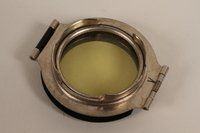
Ce-Nei yellow camera filter and carton used by German Jewish US soldier
Object
Ce-Nei yellow camera filter and box owned by Rudolph Sichel, a Jewish refugee from Frankfurt, Germany, who was a US Army officer in Europe from July 1944-June 1946. In May 1936, unable to return to Germany from England because of anti-Jewish regulations, Sichel went to the US. His parents Ernst and Frieda joined him in 1940. In April 1943, Sichel enlisted in the Army and was sent to Camp Ritchie for military intelligence training. In July 1944, Sichel, Chief Interrogator, Interrogation of Prisoners of War Team 13, landed on Utah Beach in France, attached to the 104th Infantry, the Timberwolf Division. As the unit advanced through France, Belgium, and Germany, Sichel interrogated those captured. On April 11, 1945, the unit liberated Dora-Mittelbau/Nordhausen concentration camp. Sichel took photographs of the camp and other wartime events, which are part of this collection, 2003.149.1. After the war ended in May, 2nd Lt. Sichel was attached to the 9th Army. He interrogated prisoners of war and civilian witnesses and did fact finding missions for war crimes trials. In June 1946, 1st Lt. Sichel returned to the US. He was awarded a Bronze Star for his service.
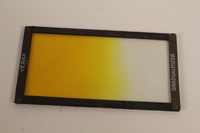
Verax camera 3 filter set and carton used by German Jewish US soldier
Object
Three yellow Verax camera filters and carton owned by Rudolph Sichel, a Jewish refugee from Frankfurt, Germany, who was a US Army officer in Europe from July 1944-June 1946. In May 1936, unable to return to Germany from England because of anti-Jewish regulations, Sichel went to the US. His parents Ernst and Frieda joined him in 1940. In April 1943, Sichel enlisted in the Army and was sent to Camp Ritchie for military intelligence training. In July 1944, Sichel, Chief Interrogator, Interrogation of Prisoners of War Team 13, landed on Utah Beach in France, attached to the 104th Infantry, the Timberwolf Division. As the unit advanced through France, Belgium, and Germany, Sichel interrogated those captured. On April 11, 1945, the unit liberated Dora-Mittelbau/Nordhausen concentration camp. Sichel took photographs of the camp and other wartime events, which are part of this collection, 2003.149.1. After the war ended in May, 2nd Lt. Sichel was attached to the 9th Army. He interrogated prisoners of war and civilian witnesses and did fact finding missions for war crimes trials. In June 1946, 1st Lt. Sichel returned to the US. He was awarded a Bronze Star for his service.
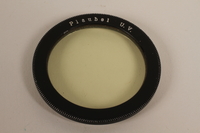
Four Plaubel color camera filters, lens, and case used by German Jewish US soldier
Object
Set of 4 color camera filters, a clear T 1.5 lens for a Plaubel camera, and fitted case owned by Rudolph Sichel, a Jewish refugee from Frankfurt, Germany, who was a US Army officer in Europe from July 1944-June 1946. In May 1936, unable to return to Germany from England because of anti-Jewish regulations, Sichel went to the US. His parents Ernst and Frieda joined him in 1940. In April 1943, Sichel enlisted in the Army and was sent to Camp Ritchie for military intelligence training. In July 1944, Sichel, Chief Interrogator, Interrogation of Prisoners of War Team 13, landed on Utah Beach in France, attached to the 104th Infantry, the Timberwolf Division. As the unit advanced through France, Belgium, and Germany, Sichel interrogated those captured. On April 11, 1945, the unit liberated Dora-Mittelbau/Nordhausen concentration camp. Sichel took photographs of the camp and other wartime events, which are part of this collection, 2003.149.1. After the war ended in May, 2nd Lt. Sichel was attached to the 9th Army. He interrogated prisoners of war and civilian witnesses and did fact finding missions for war crimes trials. In June 1946, 1st Lt. Sichel returned to the US. He was awarded a Bronze Star for his service.
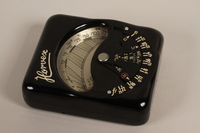
Horvex light meter, case, and notes used by German Jewish US soldier
Object
Horvex selenium light meter, case, and note owned by Rudolph Sichel, a Jewish refugee from Frankfurt, Germany, who was a US Army officer in Europe from July 1944-June 1946. In May 1936, unable to return to Germany from England because of anti-Jewish regulations, Sichel went to the US. His parents Ernst and Frieda joined him in 1940. In April 1943, Sichel enlisted in the Army and was sent to Camp Ritchie for military intelligence training. In July 1944, Sichel, Chief Interrogator, Interrogation of Prisoners of War Team 13, landed on Utah Beach in France, attached to the 104th Infantry, the Timberwolf Division. As the unit advanced through France, Belgium, and Germany, Sichel interrogated those captured. On April 11, 1945, the unit liberated Dora-Mittelbau/Nordhausen concentration camp. Sichel took photographs of the camp and other wartime events, which are part of this collection, 2003.149.1. After the war ended in May, 2nd Lt. Sichel was attached to the 9th Army. He interrogated prisoners of war and civilian witnesses and did fact finding missions for war crimes trials. In June 1946, 1st Lt. Sichel returned to the US. He was awarded a Bronze Star for his service.
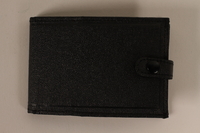
Magnifying lens for a camera used by German Jewish US soldier
Object
Magnifying lens for a camera enclosed in a folding case owned by Rudolph Sichel, a Jewish refugee from Frankfurt, Germany, who was a US Army officer in Europe from July 1944-June 1946. In May 1936, unable to return to Germany from England because of anti-Jewish regulations, Sichel went to the US. His parents Ernst and Frieda joined him in 1940. In April 1943, Sichel enlisted in the Army and was sent to Camp Ritchie for military intelligence training. In July 1944, Sichel, Chief Interrogator, Interrogation of Prisoners of War Team 13, landed on Utah Beach in France, attached to the 104th Infantry, the Timberwolf Division. As the unit advanced through France, Belgium, and Germany, Sichel interrogated those captured. On April 11, 1945, the unit liberated Dora-Mittelbau/Nordhausen concentration camp. Sichel took photographs of the camp and other wartime events, which are part of this collection, 2003.149.1. After the war ended in May, 2nd Lt. Sichel was attached to the 9th Army. He interrogated prisoners of war and civilian witnesses and did fact finding missions for war crimes trials. In June 1946, 1st Lt. Sichel returned to the US. He was awarded a Bronze Star for his service.
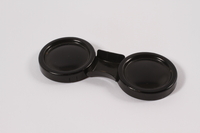
Double lens cap for twin reflex camera used by a German Jewish US soldier
Object
Double lens cap for a twin reflex camera, likely a Rolleiflex, owned by Rudolph Sichel, a Jewish refugee from Frankfurt, Germany, who was a US Army officer in Europe from July 1944-June 1946. In May 1936, unable to return to Germany from England because of anti-Jewish regulations, Sichel went to the US. His parents Ernst and Frieda joined him in 1940. In April 1943, Sichel enlisted in the Army and was sent to Camp Ritchie for military intelligence training. In July 1944, Sichel, Chief Interrogator, Interrogation of Prisoners of War Team 13, landed on Utah Beach in France, attached to the 104th Infantry, the Timberwolf Division. As the unit advanced through France, Belgium, and Germany, Sichel interrogated those captured. On April 11, 1945, the unit liberated Dora-Mittelbau/Nordhausen concentration camp. Sichel took photographs of the camp and other wartime events, which are part of this collection, 2003.149.1. After the war ended in May, 2nd Lt. Sichel was attached to the 9th Army. He interrogated prisoners of war and civilian witnesses and did fact finding missions for war crimes trials. In June 1946, 1st Lt. Sichel returned to the US. He was awarded a Bronze Star for his service.
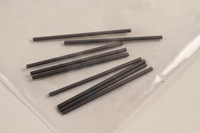
Small metal case with 9 pencil leads used by a German Jewish US soldier
Object
Metal pencil case with 9 pencil leads for a mechanical pencil owned by Rudolph Sichel, a Jewish refugee from Frankfurt, Germany, who was a US Army officer in Europe from July 1944-June 1946. In May 1936, unable to return to Germany from England because of anti-Jewish regulations, Sichel went to the US. His parents Ernst and Frieda joined him in 1940. In April 1943, Sichel enlisted in the Army and was sent to Camp Ritchie for military intelligence training. In July 1944, Sichel, Chief Interrogator, Interrogation of Prisoners of War Team 13, landed on Utah Beach in France, attached to the 104th Infantry, the Timberwolf Division. As the unit advanced through France, Belgium, and Germany, Sichel interrogated those captured. On April 11, 1945, the unit liberated Dora-Mittelbau/Nordhausen concentration camp. Sichel took photographs of the camp and other wartime events, which are part of this collection, 2003.149.1. After the war ended in May, 2nd Lt. Sichel was attached to the 9th Army. He interrogated prisoners of war and civilian witnesses and did fact finding missions for war crimes trials. In June 1946, 1st Lt. Sichel returned to the US. He was awarded a Bronze Star for his service.
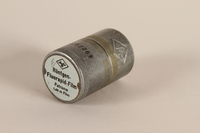
Agfa metal film canister used by a German Jewish US soldier
Object
Agfa metal film canister used by Rudolph Sichel, a Jewish refugee from Frankfurt, Germany, who was a US Army officer in Europe from July 1944-June 1946. In May 1936, unable to return to Germany from England because of anti-Jewish regulations, Sichel went to the US. His parents Ernst and Frieda joined him in 1940. In April 1943, Sichel enlisted in the Army and was sent to Camp Ritchie for military intelligence training. In July 1944, Sichel, Chief Interrogator, Interrogation of Prisoners of War Team 13, landed on Utah Beach in France, attached to the 104th Infantry, the Timberwolf Division. As the unit advanced through France, Belgium, and Germany, Sichel interrogated those captured. On April 11, 1945, the unit liberated Dora-Mittelbau/Nordhausen concentration camp. Sichel took photographs of the camp and other wartime events, which are part of this collection, 2003.149.1. After the war ended in May, 2nd Lt. Sichel was attached to the 9th Army. He interrogated prisoners of war and civilian witnesses and did fact finding missions for war crimes trials. In June 1946, 1st Lt. Sichel returned to the US. He was awarded a Bronze Star for his service.
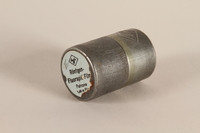
Agfa metal film canister used by German Jewish US soldier
Object
Agfa metal film canister used by Rudolph Sichel, a Jewish refugee from Frankfurt, Germany, who was a US Army officer in Europe from July 1944-June 1946. In May 1936, unable to return to Germany from England because of anti-Jewish regulations, Sichel went to the US. His parents Ernst and Frieda joined him in 1940. In April 1943, Sichel enlisted in the Army and was sent to Camp Ritchie for military intelligence training. In July 1944, Sichel, Chief Interrogator, Interrogation of Prisoners of War Team 13, landed on Utah Beach in France, attached to the 104th Infantry, the Timberwolf Division. As the unit advanced through France, Belgium, and Germany, Sichel interrogated those captured. On April 11, 1945, the unit liberated Dora-Mittelbau/Nordhausen concentration camp. Sichel took photographs of the camp and other wartime events, which are part of this collection, 2003.149.1. After the war ended in May, 2nd Lt. Sichel was attached to the 9th Army. He interrogated prisoners of war and civilian witnesses and did fact finding missions for war crimes trials. In June 1946, 1st Lt. Sichel returned to the US. He was awarded a Bronze Star for his service.
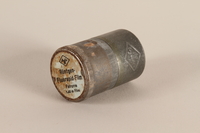
Agfa metal film canister used by German Jewish US soldier
Object
Agfa metal film canister used by Rudolph Sichel, a Jewish refugee from Frankfurt, Germany, who was a US Army officer in Europe from July 1944-June 1946. In May 1936, unable to return to Germany from England because of anti-Jewish regulations, Sichel went to the US. His parents Ernst and Frieda joined him in 1940. In April 1943, Sichel enlisted in the Army and was sent to Camp Ritchie for military intelligence training. In July 1944, Sichel, Chief Interrogator, Interrogation of Prisoners of War Team 13, landed on Utah Beach in France, attached to the 104th Infantry, the Timberwolf Division. As the unit advanced through France, Belgium, and Germany, Sichel interrogated those captured. On April 11, 1945, the unit liberated Dora-Mittelbau/Nordhausen concentration camp. Sichel took photographs of the camp and other wartime events, which are part of this collection, 2003.149.1. After the war ended in May, 2nd Lt. Sichel was attached to the 9th Army. He interrogated prisoners of war and civilian witnesses and did fact finding missions for war crimes trials. In June 1946, 1st Lt. Sichel returned to the US. He was awarded a Bronze Star for his service.
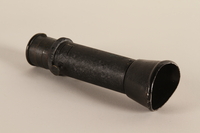
Justophot light meter and suede pouch used by German Jewish US soldier
Object
Justophot light meter with suede pouch owned by Rudolph Sichel, a Jewish refugee from Frankfurt, Germany, who was a US Army officer in Europe from July 1944-June 1946. In May 1936, unable to return to Germany from England because of anti-Jewish regulations, Sichel went to the US. His parents Ernst and Frieda joined him in 1940. In April 1943, Sichel enlisted in the Army and was sent to Camp Ritchie for military intelligence training. In July 1944, Sichel, Chief Interrogator, Interrogation of Prisoners of War Team 13, landed on Utah Beach in France, attached to the 104th Infantry, the Timberwolf Division. As the unit advanced through France, Belgium, and Germany, Sichel interrogated those captured. On April 11, 1945, the unit liberated Dora-Mittelbau/Nordhausen concentration camp. Sichel took photographs of the camp and other wartime events, which are part of this collection, 2003.149.1. After the war ended in May, 2nd Lt. Sichel was attached to the 9th Army. He interrogated prisoners of war and civilian witnesses and did fact finding missions for war crimes trials. In June 1946, 1st Lt. Sichel returned to the US. He was awarded a Bronze Star for his service.
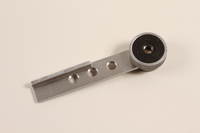
Camera accessory with knobs owned by German Jewish US soldier
Object
Metal camera accessory with knobs, perhaps a handle, owned by Rudolph Sichel, a Jewish refugee from Frankfurt, Germany, who was a US Army officer in Europe from July 1944-June 1946. In May 1936, unable to return to Germany from England because of anti-Jewish regulations, Sichel went to the US. His parents Ernst and Frieda joined him in 1940. In April 1943, Sichel enlisted in the Army and was sent to Camp Ritchie for military intelligence training. In July 1944, Sichel, Chief Interrogator, Interrogation of Prisoners of War Team 13, landed on Utah Beach in France, attached to the 104th Infantry, the Timberwolf Division. As the unit advanced through France, Belgium, and Germany, Sichel interrogated those captured. On April 11, 1945, the unit liberated Dora-Mittelbau/Nordhausen concentration camp. Sichel took photographs of the camp and other wartime events, which are part of this collection, 2003.149.1. After the war ended in May, 2nd Lt. Sichel was attached to the 9th Army. He interrogated prisoners of war and civilian witnesses and did fact finding missions for war crimes trials. In June 1946, 1st Lt. Sichel returned to the US. He was awarded a Bronze Star for his service.
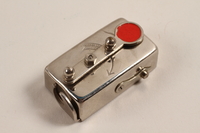
Autoknips Model I automatic timer for camera used by German Jewish US soldier
Object
Autoknips Model 1 automatic timer for a camera owned by Rudolph Sichel, a Jewish refugee from Frankfurt, Germany, who was a US Army officer in Europe from July 1944-June 1946. In May 1936, unable to return to Germany from England because of anti-Jewish regulations, Sichel went to the US. His parents Ernst and Frieda joined him in 1940. In April 1943, Sichel enlisted in the Army and was sent to Camp Ritchie for military intelligence training. In July 1944, Sichel, Chief Interrogator, Interrogation of Prisoners of War Team 13, landed on Utah Beach in France, attached to the 104th Infantry, the Timberwolf Division. As the unit advanced through France, Belgium, and Germany, Sichel interrogated those captured. On April 11, 1945, the unit liberated Dora-Mittelbau/Nordhausen concentration camp. Sichel took photographs of the camp and other wartime events, which are part of this collection, 2003.149.1. After the war ended in May, 2nd Lt. Sichel was attached to the 9th Army. He interrogated prisoners of war and civilian witnesses and did fact finding missions for war crimes trials. In June 1946, 1st Lt. Sichel returned to the US. He was awarded a Bronze Star for his service.
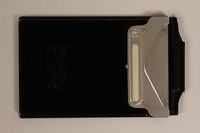
Cut film holder for Plaubel camera used by German Jewish US soldier
Object
Cut film holder for a Makina II Plaubel camera owned by Rudolph Sichel, a Jewish refugee from Frankfurt, Germany, who was a US Army officer in Europe from July 1944-June 1946. In May 1936, unable to return to Germany from England because of anti-Jewish regulations, Sichel went to the US. His parents Ernst and Frieda joined him in 1940. In April 1943, Sichel enlisted in the Army and was sent to Camp Ritchie for military intelligence training. In July 1944, Sichel, Chief Interrogator, Interrogation of Prisoners of War Team 13, landed on Utah Beach in France, attached to the 104th Infantry, the Timberwolf Division. As the unit advanced through France, Belgium, and Germany, Sichel interrogated those captured. On April 11, 1945, the unit liberated Dora-Mittelbau/Nordhausen concentration camp. Sichel took photographs of the camp and other wartime events, which are part of this collection, 2003.149.1. After the war ended in May, 2nd Lt. Sichel was attached to the 9th Army. He interrogated prisoners of war and civilian witnesses and did fact finding missions for war crimes trials. In June 1946, 1st Lt. Sichel returned to the US. He was awarded a Bronze Star for his service.
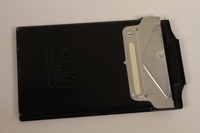
Cut film holder for Plaubel camera used by German Jewish US soldier
Object
Cut film holder for a Makina II Plaubel camera owned by Rudolph Sichel, a Jewish refugee from Frankfurt, Germany, who was a US Army officer in Europe from July 1944-June 1946. In May 1936, unable to return to Germany from England because of anti-Jewish regulations, Sichel went to the US. His parents Ernst and Frieda joined him in 1940. In April 1943, Sichel enlisted in the Army and was sent to Camp Ritchie for military intelligence training. In July 1944, Sichel, Chief Interrogator, Interrogation of Prisoners of War Team 13, landed on Utah Beach in France, attached to the 104th Infantry, the Timberwolf Division. As the unit advanced through France, Belgium, and Germany, Sichel interrogated those captured. On April 11, 1945, the unit liberated Dora-Mittelbau/Nordhausen concentration camp. Sichel took photographs of the camp and other wartime events, which are part of this collection, 2003.149.1. After the war ended in May, 2nd Lt. Sichel was attached to the 9th Army. He interrogated prisoners of war and civilian witnesses and did fact finding missions for war crimes trials. In June 1946, 1st Lt. Sichel returned to the US. He was awarded a Bronze Star for his service.
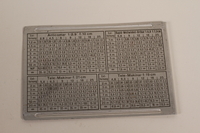
Depth of field scale plate for Plaubel camera used by German Jewish US soldier
Object
Depth of field scale plate for a Plaubel camera owned by Rudolph Sichel, a Jewish refugee from Frankfurt, Germany, who was a US Army officer in Europe from July 1944-June 1946. In May 1936, unable to return to Germany from England because of anti-Jewish regulations, Sichel went to the US. His parents Ernst and Frieda joined him in 1940. In April 1943, Sichel enlisted in the Army and was sent to Camp Ritchie for military intelligence training. In July 1944, Sichel, Chief Interrogator, Interrogation of Prisoners of War Team 13, landed on Utah Beach in France, attached to the 104th Infantry, the Timberwolf Division. As the unit advanced through France, Belgium, and Germany, Sichel interrogated those captured. On April 11, 1945, the unit liberated Dora-Mittelbau/Nordhausen concentration camp. Sichel took photographs of the camp and other wartime events, which are part of this collection, 2003.149.1. After the war ended in May, 2nd Lt. Sichel was attached to the 9th Army. He interrogated prisoners of war and civilian witnesses and did fact finding missions for war crimes trials. In June 1946, 1st Lt. Sichel returned to the US. He was awarded a Bronze Star for his service.
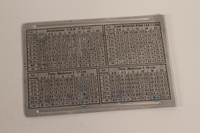
Depth of field scale plate for Plaubel camera used by German Jewish US soldier
Object
Depth of field scale plate for a Plaubel camera owned by Rudolph Sichel, a Jewish refugee from Frankfurt, Germany, who was a US Army officer in Europe from July 1944-June 1946. In May 1936, unable to return to Germany from England because of anti-Jewish regulations, Sichel went to the US. His parents Ernst and Frieda joined him in 1940. In April 1943, Sichel enlisted in the Army and was sent to Camp Ritchie for military intelligence training. In July 1944, Sichel, Chief Interrogator, Interrogation of Prisoners of War Team 13, landed on Utah Beach in France, attached to the 104th Infantry, the Timberwolf Division. As the unit advanced through France, Belgium, and Germany, Sichel interrogated those captured. On April 11, 1945, the unit liberated Dora-Mittelbau/Nordhausen concentration camp. Sichel took photographs of the camp and other wartime events, which are part of this collection, 2003.149.1. After the war ended in May, 2nd Lt. Sichel was attached to the 9th Army. He interrogated prisoners of war and civilian witnesses and did fact finding missions for war crimes trials. In June 1946, 1st Lt. Sichel returned to the US. He was awarded a Bronze Star for his service.
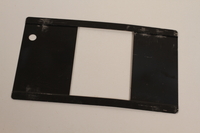
Metal viewfinder mask for camera used by German Jewish US soldier
Object
Camera viewfinder mask owned by Rudolph Sichel, a Jewish refugee from Frankfurt, Germany, who was a US Army officer in Europe from July 1944-June 1946. In May 1936, unable to return to Germany from England because of anti-Jewish regulations, Sichel went to the US. His parents Ernst and Frieda joined him in 1940. In April 1943, Sichel enlisted in the Army and was sent to Camp Ritchie for military intelligence training. In July 1944, Sichel, Chief Interrogator, Interrogation of Prisoners of War Team 13, landed on Utah Beach in France, attached to the 104th Infantry, the Timberwolf Division. As the unit advanced through France, Belgium, and Germany, Sichel interrogated those captured. On April 11, 1945, the unit liberated Dora-Mittelbau/Nordhausen concentration camp. Sichel took photographs of the camp and other wartime events, which are part of this collection, 2003.149.1. After the war ended in May, 2nd Lt. Sichel was attached to the 9th Army. He interrogated prisoners of war and civilian witnesses and did fact finding missions for war crimes trials. In June 1946, 1st Lt. Sichel returned to the US. He was awarded a Bronze Star for his service.
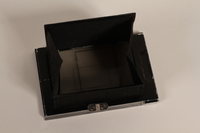
Hooded ground glass focusing back for camera used by German Jewish US soldier
Object
Hooded ground glass focusing back for a camera owned by Rudolph Sichel, a Jewish refugee from Frankfurt, Germany, who was a US Army officer in Europe from July 1944-June 1946. In May 1936, unable to return to Germany from England because of anti-Jewish regulations, Sichel went to the US. His parents Ernst and Frieda joined him in 1940. In April 1943, Sichel enlisted in the Army and was sent to Camp Ritchie for military intelligence training. In July 1944, Sichel, Chief Interrogator, Interrogation of Prisoners of War Team 13, landed on Utah Beach in France, attached to the 104th Infantry, the Timberwolf Division. As the unit advanced through France, Belgium, and Germany, Sichel interrogated those captured. On April 11, 1945, the unit liberated Dora-Mittelbau/Nordhausen concentration camp. Sichel took photographs of the camp and other wartime events, which are part of this collection, 2003.149.1. After the war ended in May, 2nd Lt. Sichel was attached to the 9th Army. He interrogated prisoners of war and civilian witnesses and did fact finding missions for war crimes trials. In June 1946, 1st Lt. Sichel returned to the US. He was awarded a Bronze Star for his service.
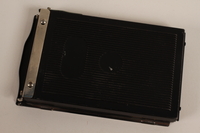
Hinged pack film holder used by German Jewish US soldier
Object
Hinged holder for pack film for a camera owned by Rudolph Sichel, a Jewish refugee from Frankfurt, Germany, who was a US Army officer in Europe from July 1944-June 1946. In May 1936, unable to return to Germany from England because of anti-Jewish regulations, Sichel went to the US. His parents Ernst and Frieda joined him in 1940. In April 1943, Sichel enlisted in the Army and was sent to Camp Ritchie for military intelligence training. In July 1944, Sichel, Chief Interrogator, Interrogation of Prisoners of War Team 13, landed on Utah Beach in France, attached to the 104th Infantry, the Timberwolf Division. As the unit advanced through France, Belgium, and Germany, Sichel interrogated those captured. On April 11, 1945, the unit liberated Dora-Mittelbau/Nordhausen concentration camp. Sichel took photographs of the camp and other wartime events, which are part of this collection, 2003.149.1. After the war ended in May, 2nd Lt. Sichel was attached to the 9th Army. He interrogated prisoners of war and civilian witnesses and did fact finding missions for war crimes trials. In June 1946, 1st Lt. Sichel returned to the US. He was awarded a Bronze Star for his service.
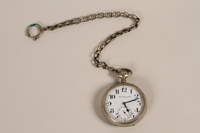
H. Moser & Cie silver pocket watch with chain owned by German Jewish US soldier
Object
Large H. Moser & Cie silver pocket watch with a separate chain owned by Rudolph Sichel, a Jewish refugee from Frankfurt, Germany, who was a US Army officer in Europe from July 1944-June 1946. In May 1936, unable to return to Germany from England because of anti-Jewish regulations, Sichel went to the US. His parents Ernst and Frieda joined him in 1940. In April 1943, Sichel enlisted in the Army and was sent to Camp Ritchie for military intelligence training. In July 1944, Sichel, Chief Interrogator, Interrogation of Prisoners of War Team 13, landed on Utah Beach in France, attached to the 104th Infantry, the Timberwolf Division. As the unit advanced through France, Belgium, and Germany, Sichel interrogated those captured. On April 11, 1945, the unit liberated Dora-Mittelbau/Nordhausen concentration camp. Sichel took photographs of the camp and other wartime events, which are part of this collection, 2003.149.1. After the war ended in May, 2nd Lt. Sichel was attached to the 9th Army. He interrogated prisoners of war and civilian witnesses and did fact finding missions for war crimes trials. In June 1946, 1st Lt. Sichel returned to the US. He was awarded a Bronze Star for his service.
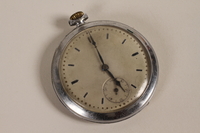
Art Deco silver pocket watch owned by German Jewish US emigre and soldier
Object
Silver pocket watch with geometric Art Deco style etching on the back owned by Rudolph Sichel, a Jewish refugee from Frankfurt, Germany, who was a US Army officer in Europe from July 1944-June 1946. In May 1936, unable to return to Germany from England because of anti-Jewish regulations, Sichel went to the US. His parents Ernst and Frieda joined him in 1940. In April 1943, Sichel enlisted in the Army and was sent to Camp Ritchie for military intelligence training. In July 1944, Sichel, Chief Interrogator, Interrogation of Prisoners of War Team 13, landed on Utah Beach in France, attached to the 104th Infantry, the Timberwolf Division. As the unit advanced through France, Belgium, and Germany, Sichel interrogated those captured. On April 11, 1945, the unit liberated Dora-Mittelbau/Nordhausen concentration camp. Sichel took photographs of the camp and other wartime events, which are part of this collection, 2003.149.1. After the war ended in May, 2nd Lt. Sichel was attached to the 9th Army. He interrogated prisoners of war and civilian witnesses and did fact finding missions for war crimes trials. In June 1946, 1st Lt. Sichel returned to the US. He was awarded a Bronze Star for his service.
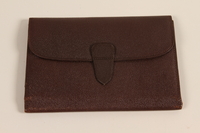
Brown leather document wallet used by German Jewish US soldier
Object
Dark brown, textured leather, document wallet with 8 pockets owned by Rudolph Sichel, a Jewish refugee from Frankfurt, Germany, who was a US Army officer in Europe from July 1944-June 1946. In May 1936, unable to return to Germany from England because of anti-Jewish regulations, Sichel went to the US. His parents Ernst and Frieda joined him in 1940. In April 1943, Sichel enlisted in the Army and was sent to Camp Ritchie for military intelligence training. In July 1944, Sichel, Chief Interrogator, Interrogation of Prisoners of War Team 13, landed on Utah Beach in France, attached to the 104th Infantry, the Timberwolf Division. As the unit advanced through France, Belgium, and Germany, Sichel interrogated those captured. On April 11, 1945, the unit liberated Dora-Mittelbau/Nordhausen concentration camp. Sichel took photographs of the camp and other wartime events, which are part of this collection, 2003.149.1. After the war ended in May, 2nd Lt. Sichel was attached to the 9th Army. He interrogated prisoners of war and civilian witnesses and did fact finding missions for war crimes trials. In June 1946, 1st Lt. Sichel returned to the US. He was awarded a Bronze Star for his service.
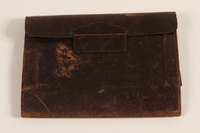
Dark brown leather document wallet used by German Jewish US soldier
Object
Well used, dark brown leather document wallet with 8 pockets owned by Rudolph Sichel, a Jewish refugee from Frankfurt, Germany, who was a US Army officer in Europe from July 1944-June 1946. In May 1936, unable to return to Germany from England because of anti-Jewish regulations, Sichel went to the US. His parents Ernst and Frieda joined him in 1940. In April 1943, Sichel enlisted in the Army and was sent to Camp Ritchie for military intelligence training. In July 1944, Sichel, Chief Interrogator, Interrogation of Prisoners of War Team 13, landed on Utah Beach in France, attached to the 104th Infantry, the Timberwolf Division. As the unit advanced through France, Belgium, and Germany, Sichel interrogated those captured. On April 11, 1945, the unit liberated Dora-Mittelbau/Nordhausen concentration camp. Sichel took photographs of the camp and other wartime events, which are part of this collection, 2003.149.1. After the war ended in May, 2nd Lt. Sichel was attached to the 9th Army. He interrogated prisoners of war and civilian witnesses and did fact finding missions for war crimes trials. In June 1946, 1st Lt. Sichel returned to the US. He was awarded a Bronze Star for his service.
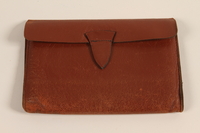
Red-brown leather document wallet used by a German Jewish refugee
Object
Red brown leather document wallet with 5 pockets and a British stamp used by Rudolph Sichel, a Jewish refugee from Frankfurt, Germany, who was a US Army officer in Europe from July 1944-June 1946. In May 1936, unable to return to Germany from England because of anti-Jewish regulations, Sichel went to the US. His parents Ernst and Frieda joined him in 1940. In April 1943, Sichel enlisted in the Army and was sent to Camp Ritchie for military intelligence training. In July 1944, Sichel, Chief Interrogator, Interrogation of Prisoners of War Team 13, landed on Utah Beach in France, attached to the 104th Infantry, the Timberwolf Division. As the unit advanced through France, Belgium, and Germany, Sichel interrogated those captured. On April 11, 1945, the unit liberated Dora-Mittelbau/Nordhausen concentration camp. Sichel took photographs of the camp and other wartime events, which are part of this collection, 2003.149.1. After the war ended in May, 2nd Lt. Sichel was attached to the 9th Army. He interrogated prisoners of war and civilian witnesses and did fact finding missions for war crimes trials. In June 1946, 1st Lt. Sichel returned to the US. He was awarded a Bronze Star for his service.
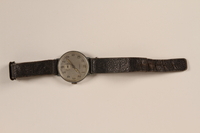
Novoris leather wrist watch worn by German Jewish emigre and US soldier
Object
Swiss made Novoris wrist watch with a black leather band owned by Rudolph Sichel, a Jewish refugee from Frankfurt, Germany, who was a US Army officer in Europe from July 1944-June 1946. In May 1936, unable to return to Germany from England because of anti-Jewish regulations, Sichel went to the US. His parents Ernst and Frieda joined him in 1940. In April 1943, Sichel enlisted in the Army and was sent to Camp Ritchie for military intelligence training. In July 1944, Sichel, Chief Interrogator, Interrogation of Prisoners of War Team 13, landed on Utah Beach in France, attached to the 104th Infantry, the Timberwolf Division. As the unit advanced through France, Belgium, and Germany, Sichel interrogated those captured. On April 11, 1945, the unit liberated Dora-Mittelbau/Nordhausen concentration camp. Sichel took photographs of the camp and other wartime events, which are part of this collection, 2003.149.1. After the war ended in May, 2nd Lt. Sichel was attached to the 9th Army. He interrogated prisoners of war and civilian witnesses and did fact finding missions for war crimes trials. In June 1946, 1st Lt. Sichel returned to the US. He was awarded a Bronze Star for his service.
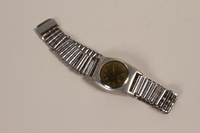
Stainless steel wrist watch owned by German Jewish emigre and US soldier
Object
Stainless steel link wrist watch with an expandable band owned by Rudolph Sichel, a Jewish refugee from Frankfurt, Germany, who was a US Army officer in Europe from July 1944-June 1946. In May 1936, unable to return to Germany from England because of anti-Jewish regulations, Sichel went to the US. His parents Ernst and Frieda joined him in 1940. In April 1943, Sichel enlisted in the Army and was sent to Camp Ritchie for military intelligence training. In July 1944, Sichel, Chief Interrogator, Interrogation of Prisoners of War Team 13, landed on Utah Beach in France, attached to the 104th Infantry, the Timberwolf Division. As the unit advanced through France, Belgium, and Germany, Sichel interrogated those captured. On April 11, 1945, the unit liberated Dora-Mittelbau/Nordhausen concentration camp. Sichel took photographs of the camp and other wartime events, which are part of this collection, 2003.149.1. After the war ended in May, 2nd Lt. Sichel was attached to the 9th Army. He interrogated prisoners of war and civilian witnesses and did fact finding missions for war crimes trials. In June 1946, 1st Lt. Sichel returned to the US. He was awarded a Bronze Star for his service.
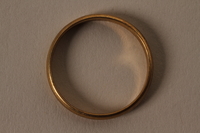
Gold ring with engraved initials and date owned by German Jewish refugee
Object
Gold finger ring engraved HM, July 11, 1936, owned by Rudolph Sichel, a Jewish refugee from Frankfurt, Germany, who was a US Army officer in Europe from July 1944-June 1946. In May 1936, unable to return to Germany from England because of anti-Jewish regulations, Sichel went to the US. His parents Ernst and Frieda joined him in 1940. In April 1943, Sichel enlisted in the Army and was sent to Camp Ritchie for military intelligence training. In July 1944, Sichel, Chief Interrogator, Interrogation of Prisoners of War Team 13, landed on Utah Beach in France, attached to the 104th Infantry, the Timberwolf Division. As the unit advanced through France, Belgium, and Germany, Sichel interrogated those captured. On April 11, 1945, the unit liberated Dora-Mittelbau/Nordhausen concentration camp. Sichel took photographs of the camp and other wartime events, which are part of this collection, 2003.149.1. After the war ended in May, 2nd Lt. Sichel was attached to the 9th Army. He interrogated prisoners of war and civilian witnesses and did fact finding missions for war crimes trials. In June 1946, 1st Lt. Sichel returned to the US. He was awarded a Bronze Star for his service.
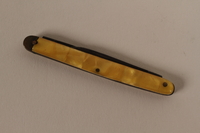
Pocket knife with yellow plastic handle used by German Jewish US soldier
Object
Small, double bladed pocket knife owned by Rudolph Sichel, a Jewish refugee from Frankfurt, Germany, who was a US Army officer in Europe from July 1944-June 1946. In May 1936, unable to return to Germany from England because of anti-Jewish regulations, Sichel went to the US. His parents Ernst and Frieda joined him in 1940. In April 1943, Sichel enlisted in the Army and was sent to Camp Ritchie for military intelligence training. In July 1944, Sichel, Chief Interrogator, Interrogation of Prisoners of War Team 13, landed on Utah Beach in France, attached to the 104th Infantry, the Timberwolf Division. As the unit advanced through France, Belgium, and Germany, Sichel interrogated those captured. On April 11, 1945, the unit liberated Dora-Mittelbau/Nordhausen concentration camp. Sichel took photographs of the camp and other wartime events, which are part of this collection, 2003.149.1. After the war ended in May, 2nd Lt. Sichel was attached to the 9th Army. He interrogated prisoners of war and civilian witnesses and did fact finding missions for war crimes trials. In June 1946, 1st Lt. Sichel returned to the US. He was awarded a Bronze Star for his service.
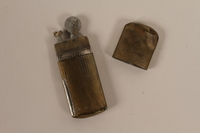
Reusable embossed cigarette lighter used by German Jewish German US soldier
Object
Reusable cigarette lighter with a ca. 1927-1945 French tax seal acquired by Rudolph Sichel, a Jewish refugee from Frankfurt, Germany, who served in the US Army in Europe from July 1944 to June 1946. In May 1936, unable to return to Germany from England because of anti-Jewish regulations, Sichel went to the US. His parents Ernst and Frieda joined him in 1940. In April 1943, Sichel enlisted in the Army and was sent to Camp Ritchie for military intelligence training. In July 1944, Sichel, Chief Interrogator, Interrogation of Prisoners of War Team 13, landed on Utah Beach in France, attached to the 104th Infantry, the Timberwolf Division. As the unit advanced through France, Belgium, and Germany, Sichel interrogated those captured. On April 11, 1945, the unit liberated Dora-Mittelbau/Nordhausen concentration camp. Sichel took photographs of the camp and other wartime events, which are part of this collection, 2003.149.1. After the war ended in May, 2nd Lt. Sichel was attached to the 9th Army. He interrogated prisoners of war and civilian witnesses and did fact finding missions for war crimes trials. In June 1946, 1st Lt. Sichel returned to the US. He was awarded a Bronze Star for his service.
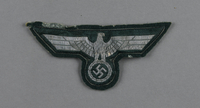
Wehrmacht silver bullion eagle insignia patch acquired by German Jewish US soldier
Object
German Army green cloth patch with a silver wire Reichsadler acquired by Rudolph Sichel, a Jewish refugee from Frankfurt, Germany, who served in the US Army in Europe from July 1944 to June 1946. In May 1936, Sichel, unable to return to Germany from England, left for the US. In April 1943, he enlisted in the army and was sent to Camp Ritchie for military intelligence training. In July 1944, Sichel, now Chief Interrogator, Interrogation of Prisoners of War Team 13, landed on Utah Beach in France, where his unit was attached to the 104th Infantry, the Timberwolf Division. As the unit advanced through France, Belgium, and into Germany, Sichel interrogated those captured. On April 11, 1945, the unit liberated Dora-Mittelbau/Nordhausen concentration camp and Rudolph witnessed the horrific conditions. A skilled photographer, he took snapshots of the camp and other events of his military tour. Following Germany’s surrender in May, 2nd Lt. Sichel was attached to the 9th Army. He interrogated prisoners of war and civilian witnesses, and did fact finding for war crimes trials. In June 1946, 1st Lt. Sichel returned to the US. He was awarded a Bronze Star for his service.
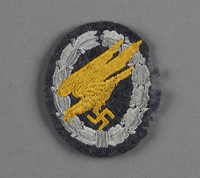
Luftwaffe paratrooper badge with gold diving eagle acquired by German Jewish US soldier
Object
Luftwaffe (German Air Force) paratroopers badge, with a gold diving eagle over a silver wreath acquired by Rudolph Sichel, a Jewish refugee from Frankfurt, Germany, who served in the US Army in Europe from July 1944 to June 1946. This type of patch was issued to airmen who had successfully completed six jumps. In May 1936, Sichel, unable to return to Germany from England, left for the US. In April 1943, he enlisted in the army and was sent to Camp Ritchie for military intelligence training. In July 1944, Sichel, now Chief Interrogator, Interrogation of Prisoners of War Team 13, landed on Utah Beach in France, where his unit was attached to the 104th Infantry, the Timberwolf Division. As the unit advanced through France, Belgium, and into Germany, Sichel interrogated those captured. On April 11, 1945, the unit liberated Dora-Mittelbau/Nordhausen concentration camp and Rudolph witnessed the horrific conditions. A skilled photographer, he took snapshots of the camp and other events of his military tour. Following Germany’s surrender in May, 2nd Lt. Sichel was attached to the 9th Army. He interrogated prisoners of war and civilian witnesses, and did fact finding for war crimes trials. In June 1946, 1st Lt. Sichel returned to the US. He was awarded a Bronze Star for his service.
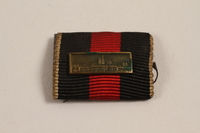
Ribbon bar for Annexation of the Sudetenland acquired by German Jewish US soldier
Object
Die Medaille zur Erinnering an den 1 Oktober 1938, a Commemorative Medal acquired by Rudolph Sichel, a Jewish refugee from Frankfurt, Germany, who served in the US Army in Europe from July 1944 to June 1946. The ribbon bar, with a Prague bar, was issued to participants in the annexation of the Sudetenland, a border region of Czechoslovakia, ceded to Hitler by the Munich Pact. In May 1936, Sichel, unable to return to Germany from England, left for the US. In April 1943, he enlisted in the army and was sent to Camp Ritchie for military intelligence training. In July 1944, Sichel, now Chief Interrogator, Interrogation of Prisoners of War Team 13, landed on Utah Beach in France, where his unit was attached to the 104th Infantry, the Timberwolf Division. As the unit advanced through France, Belgium, and into Germany, Sichel interrogated those captured. On April 11, 1945, the unit liberated Dora-Mittelbau/Nordhausen concentration camp and Rudolph witnessed the horrific conditions. A skilled photographer, he took snapshots of the camp and other events of his military tour. Following Germany’s surrender in May, 2nd Lt. Sichel was attached to the 9th Army. He interrogated prisoners of war and civilian witnesses, and did fact finding for war crimes trials. In June 1946, 1st Lt. Sichel returned to the US. He was awarded a Bronze Star for his service.
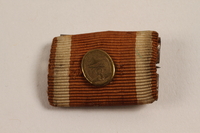
Ribbon bar award for construction of the German West Wall acquired by German Jewish US soldier
Object
Deutsches Schutzwall-Ehrenzeichen ribbon bar commemorating construction of the German West Wall acquired by Rudolph Sichel, a Jewish refugee from Frankfurt, Germany, who served in the US Army in Europe from July 1944 to June 1946. The West Wall medal was issued from August 2, 1939, to January 31, 1941, to those who built the fortifications along German’s western boundary, or were stationed there prior to May 4, 1940. In May 1936, Sichel, unable to return to Germany from England, left for the US. In April 1943, he enlisted in the army and was sent to Camp Ritchie for military intelligence training. In July 1944, Sichel, now Chief Interrogator, Interrogation of Prisoners of War Team 13, landed on Utah Beach in France, where his unit was attached to the 104th Infantry, the Timberwolf Division. As the unit advanced through France, Belgium, and into Germany, Sichel interrogated those captured. On April 11, 1945, the unit liberated Dora-Mittelbau/Nordhausen concentration camp and Rudolph witnessed the horrific conditions. A skilled photographer, he took snapshots of the camp and other events of his military tour. Following Germany’s surrender in May, 2nd Lt. Sichel was attached to the 9th Army. He interrogated prisoners of war and civilian witnesses and did fact finding for war crimes trials. In June 1946, 1st Lt. Sichel returned to the US. He was awarded a Bronze Star for his service.
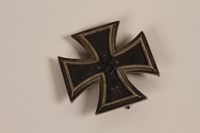
Iron Cross, 1st class, medal from WWII acquired by a Jewish German emigre and US soldier
Object
Iron Cross, 1st class, medal, dated 1939 acquired by Rudolph Sichel, a Jewish refugee from Frankfurt, Germany, who served in the US Army in Europe from July 1944 to June 1946. The 1st class medal was awarded to soldiers of the German Army who performed 4 or 5 acts of bravery. In May 1936, Sichel, unable to return to Germany from England, left for the US. In April 1943, he enlisted in the army and was sent to Camp Ritchie for military intelligence training. In July 1944, Sichel, now Chief Interrogator, Interrogation of Prisoners of War Team 13, landed on Utah Beach in France, where his unit was attached to the 104th Infantry, the Timberwolf Division. As the unit advanced through France, Belgium, and into Germany, Sichel interrogated those captured. On April 11, 1945, the unit liberated Dora-Mittelbau/Nordhausen concentration camp and Rudolph witnessed the horrific conditions. A skilled photographer, he took snapshots of the camp and other events of his military tour. Following Germany’s surrender in May, 2nd Lt. Sichel was attached to the 9th Army. He interrogated prisoners of war and civilian witnesses, and did fact finding for war crimes trials. In June 1946, 1st Lt. Sichel returned to the US. He was awarded a Bronze Star for his service.
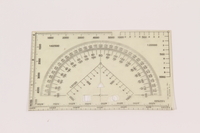
Military protractor with map coordinators used by German Jewish US soldier
Object
Plastic military protractor with 3 right angle map coordinators used by Rudolph Sichel, a Jewish refugee from Frankfurt, Germany, who served in the US Army in Europe from July 1944 to June 1946. The protractor is used with a military map with preprinted gridlines to help a soldier figure out locations and gauge distance. In May 1936, unable to return to Germany from England because of anti-Jewish regulations, Sichel went to the US. His parents Ernst and Frieda joined him in 1940. In April 1943, Sichel enlisted in the Army and was sent to Camp Ritchie for military intelligence training. In July 1944, Sichel, Chief Interrogator, Interrogation of Prisoners of War Team 13, landed on Utah Beach in France, attached to the 104th Infantry, the Timberwolf Division. As the unit advanced through France, Belgium, and Germany, Sichel interrogated those captured. On April 11, 1945, the unit liberated Dora-Mittelbau/Nordhausen concentration camp. Sichel took photographs of the camp and other wartime events, which are part of this collection, 2003.149.1. After the war ended in May, 2nd Lt. Sichel was attached to the 9th Army. He interrogated prisoners of war and civilian witnesses and did fact finding missions for war crimes trials. In June 1946, 1st Lt. Sichel returned to the US. He was awarded a Bronze Star for his service.
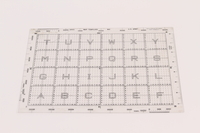
U.S. Army M2 clear plastic map template grid used by German Jewish US soldier
Object
Plastic U.S. Army M2 map template grid used by Rudolph Sichel, a Jewish refugee from Frankfurt, Germany, who served in the US Army in Europe from July 1944 to June 1946. The template was used with a military map or aerial photographs to help a soldier determine location and gauge distance. A point on the grid is selected and lined up with a numerical or topographical point on the map or photo, which represents a geographical point in actual terrain. In May 1936, unable to return to Germany from England because of anti-Jewish regulations, Sichel went to the US. His parents Ernst and Frieda joined him in 1940. In April 1943, Sichel enlisted in the Army and was sent to Camp Ritchie for military intelligence training. In July 1944, Sichel, Chief Interrogator, Interrogation of Prisoners of War Team 13, landed on Utah Beach in France, attached to the 104th Infantry, the Timberwolf Division. As the unit advanced through France, Belgium, and Germany, Sichel interrogated those captured. On April 11, 1945, the unit liberated Dora-Mittelbau/Nordhausen concentration camp. Sichel took photographs of the camp and other wartime events, which are part of this collection, 2003.149.1. After the war ended in May, 2nd Lt. Sichel was attached to the 9th Army. He interrogated prisoners of war and civilian witnesses and did fact finding missions for war crimes trials. In June 1946, 1st Lt. Sichel returned to the US. He was awarded a Bronze Star for his service.
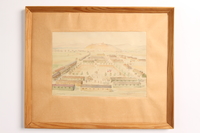
Watercolor of a POW camp owned by German Jewish US soldier
Object
Watercolor Gustav Adolph Weigand owned by Rudolph Sichel, a Jewish refugee from Frankfurt, Germany, who served in the US Army from 1943 to June 1946. In May 1936, unable to return to Germany from England because of anti-Jewish regulations, Sichel went to the US. His parents Ernst and Frieda joined him in 1940. In April 1943, Sichel enlisted in the Army and was sent to Camp Ritchie for military intelligence training. In July 1944, Sichel, Chief Interrogator, Interrogation of Prisoners of War Team 13, landed on Utah Beach in France, attached to the 104th Infantry, the Timberwolf Division. As the unit advanced through France, Belgium, and Germany, Sichel interrogated those captured. On April 11, 1945, the unit liberated Dora-Mittelbau/Nordhausen concentration camp. Sichel took photographs of the camp and other wartime events, which are part of this collection, 2003.149.1. After the war ended in May, 2nd Lt. Sichel was attached to the 9th Army. He interrogated prisoners of war and civilian witnesses and did fact finding missions for war crimes trials. In June 1946, 1st Lt. Sichel returned to the US. He was awarded a Bronze Star for his service.
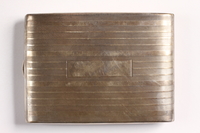
Felmore Art Deco cigarette case owned by German Jewish emigre and US soldier
Object
Engraved sterling silver Felmore cigarette case with gilt interior owned by Rudolph Sichel, a Jewish refugee from Frankfurt, Germany, who served in the US Army from 1943 to June 1946. In May 1936, unable to return to Germany from England because of anti-Jewish regulations, Sichel went to the US. His parents Ernst and Frieda joined him in 1940. In April 1943, Sichel enlisted in the Army and was sent to Camp Ritchie for military intelligence training. In July 1944, Sichel, Chief Interrogator, Interrogation of Prisoners of War Team 13, landed on Utah Beach in France, attached to the 104th Infantry, the Timberwolf Division. As the unit advanced through France, Belgium, and Germany, Sichel interrogated those captured. On April 11, 1945, the unit liberated Dora-Mittelbau/Nordhausen concentration camp. Sichel took photographs of the camp and other wartime events, which are part of this collection, 2003.149.1. After the war ended in May, 2nd Lt. Sichel was attached to the 9th Army. He interrogated prisoners of war and civilian witnesses and did fact finding missions for war crimes trials. In June 1946, 1st Lt. Sichel returned to the US. He was awarded a Bronze Star for his service.
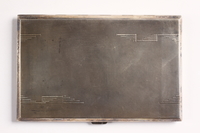
Engraved cigarette case given to a German Jewish emigre
Object
Engraved cigarette case owned by Rudolph Sichel, a Jewish refugee from Frankfurt, Germany, who served in the US Army from 1943 to June 1946. In May 1936, unable to return to Germany from England because of anti-Jewish regulations, Sichel went to the US. His parents Ernst and Frieda joined him in 1940. In April 1943, Sichel enlisted in the Army and was sent to Camp Ritchie for military intelligence training. In July 1944, Sichel, Chief Interrogator, Interrogation of Prisoners of War Team 13, landed on Utah Beach in France, attached to the 104th Infantry, the Timberwolf Division. As the unit advanced through France, Belgium, and Germany, Sichel interrogated those captured. On April 11, 1945, the unit liberated Dora-Mittelbau/Nordhausen concentration camp. Sichel took photographs of the camp and other wartime events, which are part of this collection, 2003.149.1. After the war ended in May, 2nd Lt. Sichel was attached to the 9th Army. He interrogated prisoners of war and civilian witnesses and did fact finding missions for war crimes trials. In June 1946, 1st Lt. Sichel returned to the US. He was awarded a Bronze Star for his service.
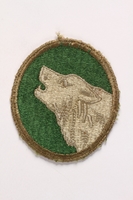
US Army 104th Infantry shoulder sleeve Timberwolf patch worn by a soldier
Object
US Army 104th Infantry Division shoulder sleeve Timberwolf patch worn by Rudolph Sichel, a Jewish refugee from Frankfurt, Germany, who served in the US Army from 1943 to June 1946, from 1945-1946 as a 2nd Lt. In May 1936, unable to return to Germany from England because of anti-Jewish regulations, Sichel went to the US. His parents Ernst and Frieda joined him in 1940. In April 1943, Sichel enlisted in the Army and was sent to Camp Ritchie for military intelligence training. In July 1944, Sichel, Chief Interrogator, Interrogation of Prisoners of War Team 13, landed on Utah Beach in France, attached to the 104th Infantry, the Timberwolf Division. As the unit advanced through France, Belgium, and Germany, Sichel interrogated those captured. On April 11, 1945, the unit liberated Dora-Mittelbau/Nordhausen concentration camp. Sichel took photographs of the camp and other wartime events, which are part of this collection, 2003.149.1. After the war ended in May, 2nd Lt. Sichel was attached to the 9th Army. He interrogated prisoners of war and civilian witnesses and did fact finding missions for war crimes trials. In June 1946, 1st Lt. Sichel returned to the US. He was awarded a Bronze Star for his service.
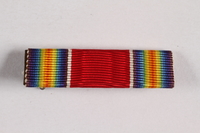
World War II Victory ribbon bar awarded to German Jewish US soldier
Object
World War II Victory ribbon bar issued to Rudolph Sichel, a Jewish refugee from Frankfurt, Germany, who served in the US Army from 1943 to June 1946. In May 1936, unable to return to Germany from England because of anti-Jewish regulations, Sichel went to the US. His parents Ernst and Frieda joined him in 1940. In April 1943, Sichel enlisted in the Army and was sent to Camp Ritchie for military intelligence training. In July 1944, Sichel, Chief Interrogator, Interrogation of Prisoners of War Team 13, landed on Utah Beach in France, attached to the 104th Infantry, the Timberwolf Division. As the unit advanced through France, Belgium, and Germany, Sichel interrogated those captured. On April 11, 1945, the unit liberated Dora-Mittelbau/Nordhausen concentration camp. Sichel took photographs of the camp and other wartime events, which are part of this collection, 2003.149.1. After the war ended in May, 2nd Lt. Sichel was attached to the 9th Army. He interrogated prisoners of war and civilian witnesses and did fact finding missions for war crimes trials. In June 1946, 1st Lt. Sichel returned to the US. He was awarded a Bronze Star for his service.
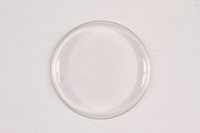
Replacement watch crystal in packaging owned by German Jewish US soldier
Object
Replacement watch crystal in storage packet owned by Rudolph Sichel, a Jewish refugee from Frankfurt, Germany, who was a US Army officer in Europe from July 1944-June 1946. In May 1936, unable to return to Germany from England because of anti-Jewish regulations, Sichel went to the US. His parents Ernst and Frieda joined him in 1940. In April 1943, Sichel enlisted in the Army and was sent to Camp Ritchie for military intelligence training. In July 1944, Sichel, Chief Interrogator, Interrogation of Prisoners of War Team 13, landed on Utah Beach in France, attached to the 104th Infantry, the Timberwolf Division. As the unit advanced through France, Belgium, and Germany, Sichel interrogated those captured. On April 11, 1945, the unit liberated Dora-Mittelbau/Nordhausen concentration camp. Sichel took photographs of the camp and other wartime events, which are part of this collection, 2003.149.1. After the war ended in May, 2nd Lt. Sichel was attached to the 9th Army. He interrogated prisoners of war and civilian witnesses and did fact finding missions for war crimes trials. In June 1946, 1st Lt. Sichel returned to the US. He was awarded a Bronze Star for his service.
Rolleiflex Model 611 camera, case, and filter used by German Jewish US soldier
Object
Rolleiflex Model 611 camera, case, and filter used by Rudolph Sichel, a Jewish refugee from Frankfurt, Germany, who served in the US Army in Europe from July 1944 to June 1946. In May 1936, unable to return to Germany from England because of anti-Jewish regulations, Sichel went to the US. His parents Ernst and Frieda joined him in 1940. In April 1943, Sichel enlisted in the Army and was sent to Camp Ritchie for military intelligence training. In July 1944, Sichel, Chief Interrogator, Interrogation of Prisoners of War Team 13, landed on Utah Beach in France, attached to the 104th Infantry, the Timberwolf Division. As the unit advanced through France, Belgium, and Germany, Sichel interrogated those captured. On April 11, 1945, the unit liberated Dora-Mittelbau/Nordhausen concentration camp. Sichel took photographs of the camp and other wartime events, which are part of this collection, 2003.149.1. After the war ended in May, 2nd Lt. Sichel was attached to the 9th Army. He interrogated prisoners of war and civilian witnesses and did fact finding missions for war crimes trials. In June 1946, 1st Lt. Sichel returned to the US. He was awarded a Bronze Star for his service.
Accessories catalog for Plaubel Makina II camera used by German Jewish US soldier
Object
Plaubel Makina II camera accessories catalog owned by Rudolph Sichel, a Jewish refugee from Frankfurt, Germany, who served in the US Army in Europe from July 1944 to June 1946. In May 1936, unable to return to Germany from England because of anti-Jewish regulations, Sichel went to the US. His parents Ernst and Frieda joined him in 1940. In April 1943, Sichel enlisted in the Army and was sent to Camp Ritchie for military intelligence training. In July 1944, Sichel, Chief Interrogator, Interrogation of Prisoners of War Team 13, landed on Utah Beach in France, attached to the 104th Infantry, the Timberwolf Division. As the unit advanced through France, Belgium, and Germany, Sichel interrogated those captured. On April 11, 1945, the unit liberated Dora-Mittelbau/Nordhausen concentration camp. Sichel took photographs of the camp and other wartime events, which are part of this collection, 2003.149.1. After the war ended in May, 2nd Lt. Sichel was attached to the 9th Army. He interrogated prisoners of war and civilian witnesses and did fact finding missions for war crimes trials. In June 1946, 1st Lt. Sichel returned to the US. He was awarded a Bronze Star for his service.
Manual for Plaubel Rollfilm-Kassette film holder used by German Jewish US soldier
Object
Manual for a Plaubel Rollfilm-Kassette film holder owned by Rudolph Sichel, a Jewish refugee from Frankfurt, Germany, who served in the US Army in Europe from July 1944 to June 1946. In May 1936, unable to return to Germany from England because of anti-Jewish regulations, Sichel went to the US. His parents Ernst and Frieda joined him in 1940. In April 1943, Sichel enlisted in the Army and was sent to Camp Ritchie for military intelligence training. In July 1944, Sichel, Chief Interrogator, Interrogation of Prisoners of War Team 13, landed on Utah Beach in France, attached to the 104th Infantry, the Timberwolf Division. As the unit advanced through France, Belgium, and Germany, Sichel interrogated those captured. On April 11, 1945, the unit liberated Dora-Mittelbau/Nordhausen concentration camp. Sichel took photographs of the camp and other wartime events, which are part of this collection, 2003.149.1. After the war ended in May, 2nd Lt. Sichel was attached to the 9th Army. He interrogated prisoners of war and civilian witnesses and did fact finding missions for war crimes trials. In June 1946, 1st Lt. Sichel returned to the US. He was awarded a Bronze Star for his service.
Manual for Plaubel Makina II camera used by German Jewish US soldier
Object
Plaubel Makina II camera instruction manual owned by Rudolph Sichel, a Jewish refugee from Frankfurt, Germany, who served in the US Army in Europe from July 1944 to June 1946. In May 1936, unable to return to Germany from England because of anti-Jewish regulations, Sichel went to the US. His parents Ernst and Frieda joined him in 1940. In April 1943, Sichel enlisted in the Army and was sent to Camp Ritchie for military intelligence training. In July 1944, Sichel, Chief Interrogator, Interrogation of Prisoners of War Team 13, landed on Utah Beach in France, attached to the 104th Infantry, the Timberwolf Division. As the unit advanced through France, Belgium, and Germany, Sichel interrogated those captured. On April 11, 1945, the unit liberated Dora-Mittelbau/Nordhausen concentration camp. Sichel took photographs of the camp and other wartime events, which are part of this collection, 2003.149.1. After the war ended in May, 2nd Lt. Sichel was attached to the 9th Army. He interrogated prisoners of war and civilian witnesses and did fact finding missions for war crimes trials. In June 1946, 1st Lt. Sichel returned to the US. He was awarded a Bronze Star for his service.
Unused forced labor badge, yellow and purple P, acquired by German Jewish US soldier
Object
Unused forced labor badge, yellow with a purple P, acquired by Rudolph Sichel, a Jewish refugee from Frankfurt, Germany, who served in the US Army in Europe from July 1944 to June 1946. The badges were worn by Polish forced laborers in German territory, circa 1940-1945, to make them easy to identify and keep separate from the local populace. In May 1936, unable to return to Germany from England because of anti-Jewish regulations, Sichel went to the US. His parents Ernst and Frieda joined him in 1940. In April 1943, Sichel enlisted in the Army and was sent to Camp Ritchie for military intelligence training. In July 1944, Sichel, Chief Interrogator, Interrogation of Prisoners of War Team 13, landed on Utah Beach in France, attached to the 104th Infantry, the Timberwolf Division. As the unit advanced through France, Belgium, and Germany, Sichel interrogated those captured. On April 11, 1945, the unit liberated Dora-Mittelbau/Nordhausen concentration camp. Sichel took photographs of the camp and other wartime events, which are part of this collection, 2003.149.1. After the war ended in May, 2nd Lt. Sichel was attached to the 9th Army. He interrogated prisoners of war and civilian witnesses and did fact finding missions for war crimes trials. In June 1946, 1st Lt. Sichel returned to the US. He was awarded a Bronze Star for his service.
Blue, white, and red striped patch with Cross of Lorraine acquired by German Jewish US soldier
Object
Blue, white, and red cloth badge with a double-barred cross acquired by Rudolph Sichel, a Jewish refugee from Frankfurt, Germany, who served in the US Army in Europe from July 1944 to June 1946. The patch is similar to those used by Free French Forces and the French Resistance following the German invasion of France in 1940. British and US soldiers often wore similar patches when entering France to identify themselves as allies. In May 1936, unable to return to Germany from England because of anti-Jewish regulations, Sichel went to the US. His parents Ernst and Frieda joined him in 1940. In April 1943, Sichel enlisted in the Army and was sent to Camp Ritchie for military intelligence training. In July 1944, Sichel, Chief Interrogator, Interrogation of Prisoners of War Team 13, landed on Utah Beach in France, attached to the 104th Infantry, the Timberwolf Division. As the unit advanced through France, Belgium, and Germany, Sichel interrogated those captured. On April 11, 1945, the unit liberated Dora-Mittelbau/Nordhausen concentration camp. Sichel took photographs of the camp and other wartime events, which are part of this collection, 2003.149.1. After the war ended in May, 2nd Lt. Sichel was attached to the 9th Army. He interrogated prisoners of war and civilian witnesses and did fact finding missions for war crimes trials. In June 1946, 1st Lt. Sichel returned to the US. He was awarded a Bronze Star for his service.
Blue, white, and red striped patch with Cross of Lorraine acquired by German Jewish US soldier
Object
Blue, white, and red cloth badge with a double-barred cross acquired by Rudolph Sichel, a Jewish refugee from Frankfurt, Germany, who served in the US Army in Europe from July 1944 to June 1946. The patch is similar to those used by Free French Forces and the French Resistance following the German invasion of France in 1940. British and US soldiers often wore similar patches when entering France to identify themselves as allies. In May 1936, unable to return to Germany from England because of anti-Jewish regulations, Sichel went to the US. His parents Ernst and Frieda joined him in 1940. In April 1943, Sichel enlisted in the Army and was sent to Camp Ritchie for military intelligence training. In July 1944, Sichel, Chief Interrogator, Interrogation of Prisoners of War Team 13, landed on Utah Beach in France, attached to the 104th Infantry, the Timberwolf Division. As the unit advanced through France, Belgium, and Germany, Sichel interrogated those captured. On April 11, 1945, the unit liberated Dora-Mittelbau/Nordhausen concentration camp. Sichel took photographs of the camp and other wartime events, which are part of this collection, 2003.149.1. After the war ended in May, 2nd Lt. Sichel was attached to the 9th Army. He interrogated prisoners of war and civilian witnesses and did fact finding missions for war crimes trials. In June 1946, 1st Lt. Sichel returned to the US. He was awarded a Bronze Star for his service.
German Eastern Front medal red, blue, and white striped ribbon acquired by German Jewish US soldier
Object
Red, blue, and white striped ribbon, likely for a German Eastern Front Medal, acquired by Rudolph Sichel, a Jewish refugee from Frankfurt, Germany, who served in the US Army in Europe from July 1944 to June 1946. The Ostmedaille, Eastern Front Medal, was issued from May 26, 1942 - September 4, 1944, to recognize German soldiers for participation in the first winter of Operation Barbarossa, the invasion of the Soviet Union. In May 1936, unable to return to Germany from England, Sichel went to the US. In April 1943, he enlisted in the army and was sent to Camp Ritchie for military intelligence training. In July 1944, Sichel, now Chief Interrogator, Interrogation of Prisoners of War Team 13, landed on Utah Beach in France, where his unit was attached to the 104th Infantry, the Timberwolf Division. As the unit advanced through France, Belgium, and into Germany, Sichel interrogated those captured. On April 11, 1945, the unit liberated Dora-Mittelbau/Nordhausen concentration camp and Rudolph witnessed the horrific conditions. A skilled photographer, he took snapshots of the camp and other events of his military tour. Following Germany’s surrender in May, 2nd Lt. Sichel was attached to the 9th Army. He interrogated prisoners of war and civilian witnesses, and did fact finding for war crimes trials. In June 1946, 1st Lt. Sichel returned to the US. He was awarded a Bronze Star for his service.
Handkerchief embroidered with US and French flags acquired by German Jewish US soldier
Object
Gauzy handkerchief embroidered with US and French flags acquired by Rudolph Sichel, a Jewish refugee from Frankfurt, Germany, who served in the US Army in Europe from July 1944 to June 1946. In May 1936, unable to return to Germany from England because of anti-Jewish regulations, Sichel went to the US. His parents Ernst and Frieda joined him in 1940. In April 1943, Sichel enlisted in the Army and was sent to Camp Ritchie for military intelligence training. In July 1944, Sichel, Chief Interrogator, Interrogation of Prisoners of War Team 13, landed on Utah Beach in France, attached to the 104th Infantry, the Timberwolf Division. As the unit advanced through France, Belgium, and Germany, Sichel interrogated those captured. On April 11, 1945, the unit liberated Dora-Mittelbau/Nordhausen concentration camp. Sichel took photographs of the camp and other wartime events, which are part of this collection, 2003.149.1. After the war ended in May, 2nd Lt. Sichel was attached to the 9th Army. He interrogated prisoners of war and civilian witnesses and did fact finding missions for war crimes trials. In June 1946, 1st Lt. Sichel returned to the US. He was awarded a Bronze Star for his service.
U.S. Infantry service lapel pin worn by German Jewish US soldier
Object
Infantry service lapel pin belonging to Rudolph Sichel, a Jewish refugee from Frankfurt, Germany, who served in the US Army in Europe from July 1944 to June 1946. In May 1936, unable to return to Germany from England because of anti-Jewish regulations, Sichel went to the US. His parents Ernst and Frieda joined him in 1940. In April 1943, Sichel enlisted in the Army and was sent to Camp Ritchie for military intelligence training. In July 1944, Sichel, Chief Interrogator, Interrogation of Prisoners of War Team 13, landed on Utah Beach in France, attached to the 104th Infantry, the Timberwolf Division. As the unit advanced through France, Belgium, and Germany, Sichel interrogated those captured. On April 11, 1945, the unit liberated Dora-Mittelbau/Nordhausen concentration camp. Sichel took photographs of the camp and other wartime events, which are part of this collection, 2003.149.1. After the war ended in May, 2nd Lt. Sichel was attached to the 9th Army. He interrogated prisoners of war and civilian witnesses and did fact finding missions for war crimes trials. In June 1946, 1st Lt. Sichel returned to the US. He was awarded a Bronze Star for his service.
U.S. Army 2nd Lieutenant's insignia pin worn by German Jewish US soldier
Object
Second Lieutenant's insignia pin worn by Rudolph Sichel, a Jewish refugee from Frankfurt, Germany, who served in the US Army from 1943 to June 1946, from 1945-1946 as a 2nd Lt. In May 1936, unable to return to Frankfurt, Germany, from England because of anti-Jewish regulations, Sichel went to the US. His parents Ernst and Frieda joined him in 1940. In April 1943, Sichel enlisted in the Army and was sent to Camp Ritchie for military intelligence training. In July 1944, Sichel, Chief Interrogator, Interrogation of Prisoners of War Team 13, landed on Utah Beach in France, attached to the 104th Infantry, the Timberwolf Division. As the unit advanced through France, Belgium, and Germany, Sichel interrogated those captured. On April 11, 1945, the unit liberated Dora-Mittelbau/Nordhausen concentration camp. Sichel took photographs of the camp and other wartime events, which are part of this collection, 2003.149.1. After the war ended in May, 2nd Lt. Sichel was attached to the 9th Army. He interrogated prisoners of war and civilian witnesses and did fact finding missions for war crimes trials. In June 1946, 1st Lt. Sichel returned to the US. He was awarded a Bronze Star for his service.



